NELSON STEVENS







UNIVERSITY OF MARYLAND GLOBAL CAMPUS ARTS PROGRAM GALLERY 3501 UNIVERSITY BOULEVARD EAST ADELPHI, MD 20783
SEPTEMBER 25, 2022–JANUARY 8, 2023
SPRINGFIELD MUSEUMS MICHELE AND DONALD D’AMOUR MUSEUM OF FINE ARTS 21 EDWARDS STREET SPRINGFIELD, MA 01103
MARCH 4–SEPTEMBER 3, 2023
Catalog published in conjunction with the exhibition
Nelson Stevens: Color Rapping
© 2022 University of Maryland Global Campus. All rights reserved. Copyright credits and attribution for certain illustrations are cited internally proximate to the illustrations.
ISBN: 13:978-0-9842265-0-4 ISBN: 10:0-98442265-0-8
As president of University of Maryland Global Campus (UMGC), I am honored to introduce this special exhibition, Nelson Stevens: Color Rapping, celebrating the life and legacy of a true artist, educator, activist, and pioneer.
An artist, professor, and early member of AfriCOBRA, Nelson Stevens stood alongside leading intellectuals in the Black Arts and Black Power movements, producing moving and memorable works that celebrate the lives, culture, and achievements of Black Americans.
As his longtime friend and colleague John Bracey pointed out, Stevens looked to highlight “the beauty, the strengths, the resilience of a people who too often were visualized as drab occupants in a drab setting. . . . [His] genius as an artist was to transform the blacks, grays, and whites into a dazzlingly complex array of
bright colors that served to uplift, magnify, and glorify his subjects and the worlds they lived in and hoped for.”
For 75 years, our university has worked to open doors of opportunity and learning to broader audiences in Maryland, across the country, and around the world, and our Arts Program supports and aligns with that mission.
I hope you are inspired by Nelson Stevens’s remarkable perspective and mastery, and I thank you for your support of the arts and our Arts Program and for your belief in the power of education to transform lives.
GREGORY FOWLER, PhD PRESIDENT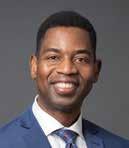 OF MARYLAND GLOBAL CAMPUS
OF MARYLAND GLOBAL CAMPUS
UNIVERSITY
Nelson Stevens was an internationally known artist whose works have graced the covers of numerous publications and are included in private collections and public museums, such as the Brooklyn Museum, Art Institute of Chicago, and National Museum of African American History and Culture. Some of his works were recently part of the traveling exhibition Soul of a Nation: Art in the Age of Black Power, organized by Tate Modern in London.
In 1972, Stevens joined the W.E.B. Du Bois Department of Afro-American Studies at the University of Massachusetts Amherst, where he met and worked with such renowned figures as Max Roach, Archie Shepp, Diana Ramos, Michael Thelwell, Paul Carter Harrison, Johnnetta Cole, Chinua Achebe, Julius Lester, Dovi Afesi, Femi Richards, and Ivanhoe Donaldson. These personalities, along with many others, would serve as inspiration for his works throughout his decades of making art.
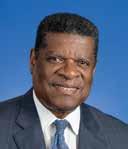
Nelson Stevens: Color Rapping is not an AfriCOBRA exhibition, although we certainly recognize the importance of that movement and the effect it had on Stevens. This exhibition is a survey of more than 50 years of the artist’s work, from his pure abstract pieces to his more recognizable “cool-ade” style paintings. These works are a testament to his love for jazz and the movement that comes with it. His brushstrokes reflect that movement in a multitude of colors that provide depth. In showcasing these works, the exhibition also focuses on the political, cultural, and socioeconomic messages in Stevens’s art and style of painting.
As word began to spread about this exhibition, Maggie North, curator of Art at the Springfield Museums in Massachusetts, contacted me to ask if they could host the exhibition at the conclusion of its run in Maryland. Knowing of Stevens’s long tenure in Massachusetts, we were more than happy to agree.
This exhibition would not be possible without the funding support of the Maryland State Arts Council, the Wolpoff Family Foundation, and University of Maryland Global Campus (UMGC). Many thanks to all those who had a hand in bringing this exhibition to fruition, including Curlee Raven Holton, director, Raven Fine Art Editions, for his invaluable assistance and Leslie King Hammond, PhD, professor emerita, Maryland Institute College of Art, and John H. Bracey Jr., professor, University of Massachusetts Amherst, for providing essays for this catalog. The UMGC Arts Program would also like to thank all the lenders to this exhibition, as well as David Lusenhop, who embraced the project and provided the necessary leadership to locate the works.
Sadly, Nelson Stevens passed away in Baltimore, Maryland, two months before the opening of this monumental exhibition, which now serves as a memorial to his art and a celebration of his life and career.
When Nelson Stevens moved to western Massachusetts in the early 1970s, he brought with him the powerful aesthetics and ideals of AfriCOBRA, the collective he had joined in Chicago while teaching at Northern Illinois University in the late 1960s. Aligned with the Black Arts movement, AfriCOBRA aimed to establish a Black aesthetic and employ art as a tool for social change. Stevens’s own creative approach within the movement, one that employed bright colors and rhythmic, powerful compositions to render inspiring depictions of Black people, countered the stereotypical images then found in the mainstream media and supported the vision of Black Americans as strong, liberated, and beautiful.
For more than 30 years, from 1972 through 2003, Stevens was a professor at the University of Massachusetts Amherst, where he taught in the Department of Art and the W.E.B. Du Bois Department of Afro-American Studies. During that time, Stevens inspired countless students, organized the publication of Drum magazine in celebration of the Black literary experience, and established an influential mural project in the city of Springfield, Massachusetts. From 1973 to 1977, Stevens galvanized Springfield residents to express the energy and positivity of the Black experience by inviting them to participate in a collaborative art project, resulting in the completion of 36 interior and exterior murals throughout the city, four of which were designed and painted by Stevens himself. Though only two of the original murals remain today, Stevens’s mural project has come full circle. On June 12, 2021, Springfield Mayor Domenic Sarno proclaimed the date as “Nelson Stevens Day,” and Stevens helped dedicate contemporary murals, including the repainting of the original mural
Heritage, during the Fresh Paint Springfield Mural Festival. This year, in September 2022, Fresh Paint Springfield will recreate two of Stevens’s murals, the 1974 I Am a Black Woman, based on a poem by Mari Evans (1923–2017) and Wall of Black Music, images of which resonate today as they did 50 years ago.
The Springfield Museums are honored to host Nelson Stevens: Color Rapping at the Michele and Donald D’Amour Museum of Fine Arts from March 4 through September 3, 2023. My special thanks to organizers Eric Key, director, and Treston Sanders, curator, of the Arts Program at University of Maryland Global Campus for generously sharing this extraordinary exhibition with the Springfield Museums. I am also grateful to my colleagues at the Springfield Museums— Kay Simpson, president and CEO; Karen Fisk, vice president of Community Investment and External Affairs; Maggie North, curator; Kris Ludwig, manager of Exhibition Services; Diane Barbarisi, registrar; and Larissa Murray, director of Education—who have enthusiastically embraced preparations for the Springfield showing. For nearly five decades, Nelson Stevens had a special relationship with and a significant impact on the arts in Springfield, promoting pride, agency, and activism in western Massachusetts and beyond. We look forward to recognizing his achievements and to sharing his important and groundbreaking artwork with our audience.
HEATHER HASKELL-BURNS VICE PRESIDENT/DIRECTOR OF ART MUSEUMS SPRINGFIELD MUSEUMS
Nelson Stevens’s artistic journey was kaleidoscopic, riddled with remarkable experiences and interactions with stellar Black intellectuals and artists in all genres of creative expression and performance. These relationships were the bedrock of his muses and cathartic inspirations for his distinctively unique aesthetic. Stevens came of age in an era when “Black is Beautiful” was more than just an anthem; it was a manifesto for the insistent demand for freedoms denied and withheld by racist protagonists and endless colonialist dogmas in the world—especially America. As a cultural warrior, Stevens used his artistic intellect and skills to create empowered, iconic compositions and numerous street murals that reflected vibrant histories of Black people and stories of unapologetic Black pride, beauty, determination, and dignity.
Stevens and his peers understood the need to refute the relentless persistence of negative imagery of Black people and their exclusion from the narratives of the history of American art. The urgency to create new ways and means to visualize Black culture and its people was palpable and demanding as the racial divide escalated during the civil rights era of the 1960s and 1970s. Black visual artists understood that the “politics of art” and the “art of politics” needed to become powerful tools, by any means necessary, essential to changing America’s dismal perception of and attitudes toward the presence of African Americans and the role they played in the founding and formation of this nation.
Stevens responded to this mandate by creating works, including murals throughout Massachusetts and at Tuskegee Institute, that layered rhythmic patterns of Black subjects immersed in spiraling spaces filled with
vivid, contrasting colors. His artistic vision created an indelible legacy of the visuality of Black Power aesthetics that illustrated ideals of empowerment and authority and celebrated the distinctiveness of African American humanity, identity, culture, and endless heroic achievements. His figurative works shined critical lights on how to more appropriately portray and represent human beings of African descent in ways that went far beyond the aesthetics of the Harlem Renaissance/New Negro era of the 1930s and 1940s. His compositions are filled with bright, saturated colors; vibrating patterns; and cursive markings. The subjects depicted are famous individuals and unknown people from the community, heroes whose bodies are projected into a realm of Afro-futuristic and otherworldly realities, inspired by America’s space explorations and the popularity of the 1966 future-forward Star Trek sci-fi series set in the 23rd century.
Stevens’s research process propelled him to focus on more African-centered subjects—classical and ancestral—that projected strength, dignity, and cultural integrity infused with reimagined Afro-futurist possibilities. The escalating social injustices and issues of African American self-determination reached new heights of visibility, political agitation, and consciousness during the eras of the Black Power and Black Arts movements. Black artists in all genres became an exhilarating, explosive force of intellectual and artistic excellence and innovation—mentoring, sharing, and teaching each other improvisational ways of creating vibrant works that voiced, mirrored, and embodied the synergies of “Black is Beautiful.”
The development of Stevens’s personal aesthetic can be specifically and especially aligned with the influence of the emboldened persona and indomitable ideologies of Malcolm X and the activism and literary contributions of theatre titan Larry Neal, who cofounded the Black Arts movement with poet and cultural critic Amiri Baraka. Baraka coined the term “freedom fighter artist” in his description of the political defiance and musical brilliance of Max Roach and Abbey Lincoln in their seminal creation of the 1960 We Insist! Max Roach’s Freedom Now Suite recording. This collaboration had a profound effect on Stevens, who had become an avid lover of improvisational avant-garde jazz music. Stevens developed a lifelong friendship, mentorship, and brotherhood with drummer Roach, who was revered for reinventing the role of the drum as a solo improvisational instrument. Sculptor Valerie Maynard, while artist-in-residence at the Studio Museum in Harlem
in 1970, greeted Stevens upon meeting him for the first time with, “Oh, so you are the color rapper!” Maynard would quite unwittingly become the muse for many of Stevens’s female portrayals.
In 1969, Stevens became a member of the arts collective AfriCOBRA (African Commune of Bad Relevant Artists), founded in 1968, joining founding members Jeff Donaldson, Elaine “Jae” Jarrell, Wadsworth Jarrell, Barbara Jones-Hogu, and Gerald Williams. The collective
grew with the addition of Napoleon Jones-Henderson, Adger Cowans, Akili Ron Anderson, Murray DePillars, James Phillips, Frank Smith, Michael Harris, Renee Stout, Kevin Cole, and several other Chicago-based artists. This collective is one of the most influential and iconic activist arts initiatives to critically address the gravity of how to visualize the aesthetics of Black consciousness in the 20th and 21st centuries. Through regular meetings steeped in rigorous critiques and discussions on concepts of Blackness as related to issues of mainstream art and world politics, they created a continuum of affordable art works for the Black community while honing their own individual artistic styles. The fundamental criteria of the collective’s manifesto were grounded in the principle dynamics of the use of intense “cool-ade” colors, positive imagery, the arbitrary use of light and line, written statements, and shine.

Stevens’s deft drawing skills and decades of experience teaching figurative studio classes honed his technical mastery of a figurative form that radiates his energy and passionate love for people of African descent. The ideological confluences of the AfriCOBRA collective and his relationships with Black intellectuals, thought leaders, and artists in all genres compelled and challenged him to push the boundaries of Western artistic canons beyond their traditions to illuminate fresh possibilities in the interpretation, representation, and perception of the Black body. The search for new strategies of visual expression led him and his peers to challenge each other to profound depths of research, experimentation, revelation, and discovery. In the catalog of the 1973 Afri-COBRA lll exhibition, Nelson Stevens’s artist statement relates with clarity the impact and intent of his journey:
As a Black image maker, it seems to me that my work cannot be about the sterility of the red, white and blue life-style but rather about exploring alternatives. I’m dealing with the cool and casual rhythms in us. Like the rhythms we walk when we believe the ground we walk on belongs to us . . . and cool like the posture we strike when we are letting a sister know our point of view on a matter of primary importance. Sometimes I deal with hot screams of the sweet thunder and the fire sirens which cause us to explode . . . but always with rhythm. Like we be doin’.
“ We declare our right on this earth to be a human being, to be respected as a human being, to be given the rights of a human being in this society, on this earth, in this day, which we intend to bring into existence by any means necessary.
—MALCOLM X, 1964Prophet, 1978, acrylic on board, 40 x 30 inches, Collection of Dr. Gregory and Katherine Demopulos LESLIE KING HAMMOND, PhD PROFESSOR EMERITA, MARYLAND INSTITUTE COLLEGE OF ART PHOTO BY DAVE ROBACK
LKH: Let’s begin with your family. Who were your parents? Did you have any siblings?
NS: My mother, Dorothy Edwards, and my father, Nelson Stevens, met in the 1930s, dancing to Duke Ellington and Count Basie at the Renaissance Ballroom in Manhattan. He was from Rochester, New York, and she was from Harlem. She thought that he was tall, tanned, and terrific. And they were married for 25 years. We lived in Brooklyn with my sister, Joyce Stevens, who was 10 months younger than me.
LKH: What kind of academic training and experiences did you have after graduating from high school and junior college?
NS: I went to junior college in Utica, New York. I then went to Ohio University and later moved to Cleveland. My experience was good at Ohio State. I was on a partial track scholarship. I ran the quarter-mile and the 220 yards and had art scholarships. During track season, they paid my tuition, books, and board from the athletic department. In the off-season or academic season, I had an academic scholarship. After graduation I started teaching junior high in Cleveland. But I was always interested in art. My art got me through junior college because I found a place in Utica where they played jazz on the weekend. And I was able to paint on the walls at that club.
LKH: Is that where your early mural painting experience began?
NS: Right! That was my first professional mural. Actually, I would do chalk drawings on the sidewalk, run up to the top of the building, and look down on my creations—those were really my first murals. [laughter]
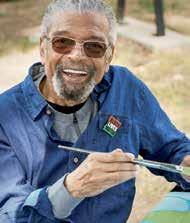
LKH: Let’s talk about how your early art experiences and attraction to jazz music grew in importance and influenced you throughout your life.
NS: I’ve always been influenced by music, even early on, earlier than the visual arts. In Brooklyn, we always had the radio on to the great music of the time. My mother liked the idea that I like to paint. She would get butcher paper from the guy that sold us meat and tack it to the wall so I wouldn’t mess up the walls as much. Every month they would tear it down, and I would start all over again. “Nelson,” she would say, “the crayons are on the radiator,” and I was painting on the walls. Always enjoyed it. Had a great time.
My grandmother was a domestic worker who worked for a visual artist, a white sculptor who did public art and commissioned portraits. His name was Bryant Baker. He had a studio on Central Park South. Every now and then, I would go with her, eat lunch with her, and feed the pigeons in Central Park. I always looked forward to that.
LKH: What was Bryant Baker like? What did you think of his art? Did he take any interest in you at all?
NS: I don’t remember him too much. What I do remember is that he gave me books or little magazines of birds and animals. I would draw them at home on my butcher paper. But he wasn’t into kids, and I wasn’t really into him. I stayed pretty much out of his way. But I discovered that, honestly, he lived very well. He had a huge apartment overlooking Central Park. I had a great time. It was during
that time in elementary school they discovered that I had talents, what they called “gifts.” They didn’t call it talent—gifts!
LKH: Art education for gifted African American children was not a priority, much less available in the curriculum. How did your family continue to support your talents?
NS: I started taking classes at the Museum of Modern Art. That’s where I discovered Picasso’s mural Guernica. A lot of people don’t know that it was exhibited in the United States during that time, before it got to the Prado in Spain. I studied it, and I didn’t like it much when I first saw it. I thought it was a little cartoony. But I learned to really respect it and to respect the idea that art could be used not for the sake of art particularly, but for the sake of educating people about what the world was like. Guernica was about the Nazi bombing of Guernica, a small town in Spain. Francisco Franco, who was ruling Spain in 1937, was a good friend of Adolph Hitler. Hitler’s first exercise with his air force, the Luftwaffe, was the flattening of Guernica. And so, Guernica was about war and the destruction of civilization.
because I’d rather play stickball outdoors with the boys than go to Manhattan and study art. There was always a tension between athletics and art.
LKH: What happened to move your life in a different direction after you got to Ohio?
NS: In junior college, I majored in advertising, design, and production. This gave me different ideas of how printed materials were important tools for creating art—ideas that were helpful after I graduated from Ohio University and began to teach. I was assigned to the worst junior high in Cleveland. They were bad! I was trying to figure out what to do with them—you know, they weren’t art majors. They had no interest in art. I was just in the art classroom with a lot of equipment. But we finally got along very well.
LKH: How did your experiences teaching young students develop your understanding of the role of art in the process of education?
NS: At the time, I was the supervisor of art, and anytime the principal came by I’d put him on the defense. I’d say, “How come you put the Black teachers in Black schools and white teachers in white schools? What’s that all about?” I did that for two years. Then he came to me and said, “Listen, you’ve been talking about white schools; I’ve got a school for you that you might like.” It was on the other side of town and was a very good school. They had what they called scholastic art exhibits. That’s where the kids entered their art in competitions that hung the work in the big department stores downtown. Department stores then were very different than now. They had great restaurants and people used to get really dressed up to go shopping. It was a different age entirely.
LKH: How old were you when you saw Picasso’s mural?
NS: I was about 8 or 9, maybe 10 years old because I was able to get to Manhattan with just a token on Saturday. But I discontinued it after a while
My kids always won awards. I came to be known that way. I did that for two years at a school that was integrated, my second school experience. Then I was attached to the Cleveland Art Museum.
I had three different things to do. I would bring classes into the museum, take things from the museum out to the classrooms, and put on a TV
“I’ve always been influenced by music, even early on.”
show about one of the room’s collections. That experience really sharpened my art historian and research capabilities. The Cleveland Museum was one of the three richest private museums in the country. They had Rodin’s The Thinker out front and several Rembrandts in their collection, and Sherman Lee was a nationally known director.
LKH: This was clearly a pivotal moment in your professional career. What was your relationship like with Sherman Lee, whose reputation in the art world was highly regarded?
NS: Sherman Lee was probably the biggest name in Asian art at that time. But every now and then he would stop by my table and say, “Did you see this African art or a particular thing?” He’d kind of direct me one way or the other. I was willing to be directed because I didn’t know what was going on. That’s when I found out about museums having 90 percent of their collection behind the walls, rather than on exhibit. I was under the impression that whatever they had was on display. It was a great job, nothing ever boring, always different day to day.
LKH: Where did the next transition in your life take you?
NS: I started doing graduate work at Kent State University. While I was at Kent, op artist and hardedge painter Richard Anuszkiewicz taught me all about the Bauhaus school, of which his work was a direct descendant. I learned how to weigh color and worked with a couple of his paintings that were yellow and red with a lot of masking tape. His paintings glowed in the dark because of their vibrant colors and precision. I also belonged to an art studio with a lot of the guys that I was partying with at the time.
I got married relatively early to my college sweetheart, Rosalyn (Lynn) Joan Fairfax. She was from Cincinnati. Her parents were educators, and they were doing really, very well. And they were very suspicious of me. [laughter] Anyway, they’d ask who my people were. And my people were my father, who wore overalls, and my mother, who was a telephone operator. Rosalyn’s parents were both
educators of note because several schools were named after them, independently, even while they were alive. They were very well respected.
I graduated from Kent State in 1969 with an MFA in art history, printmaking, and painting. I’d just met Jeff Donaldson in January of that year. He told me about AfriCOBRA and that he was forming a group in Cleveland that was particularly Black nationalist in scope with an African art philosophical overview. Jeff told me that if I could get a position close to Chicago, it would be ideal for me and for him. He had seen my artwork, and I was looking at his artwork and could see similarities in terms of where we wanted to go. Also in 1969, Lynn and I adopted our son, Marc.
Just before graduating, I ran into Paul Harrison, playwright and scholar on the theoretical structure of Black performing arts, on campus teaching a literature class. We started hanging out. We were friends until he passed away. Paul was great friends with writer Larry Neal, cofounder of the Black Arts movement with poet Amiri Baraka. Larry came to talk to his class during that summer interim. Larry and I got along famously for the next 10 years of his life, until 1981 when he passed.
LKH: How important were the relationships you had with scholars like Paul Harrison and especially Larry Neal to your intellect and need to understand the dynamics and development of Black culture and the arts?
NS: Larry devoured two or three books at home a week and talked to me like I had read the books. [laughter] He even practiced his lectures on me, which was always great because I learn better by listening than reading—my reading is not as good as it should be. So I learned how to listen really well, and I would ask pertinent questions when it was necessary to expand my understanding. Larry taught at Williams College, Yale University, and many other places. I was with Larry one weekend when some kids from Yale came to find him to ask, “You know, we’ve got this white professor who thinks he knows a lot about Black history and stuff— we want to tear him down. You ought to come to the lecture and put him in his place.”
So Larry and I went to the lecture. The guy’s name was Robert Farris Thompson. [laughter] At the end of the lecture, the kids said, “Well, what did you think of it?” And Larry said that he wished that some Black historians were as precise and as Black as Robert Farris Thompson, which didn’t excite the kids that much. They wanted another response out of Larry. We all came to find out that Robert Farris Thompson knew what he was talking about. He had been inducted into several African religions, spoke several African languages, played conga drums, knew all about everything. Kind of an interesting guy. He was one of the first white guys I ever ran into that knew about Black culture and white culture and had made determinations as to which was advanced and put them in perspective.
Larry was always good that way; he would include me in a lot of his activities. If Larry was going to a talk, he’d stop by and pick me up, or if he was writing a play, he would call me up and say, “How does this sound?” And he’d read to me. Every now and then, when people ask me how I’m doing, I say, “Copacetic.” And it’s really a tribute to Larry Neal when I do that.
LKH: That’s an absolutely beautiful example of how so many African American artists shared and cross-pollinated their concepts, research, and intellectual and spiritual energy by sharing and teaching each other during an era of still rampant segregation and racism.
NS: You like that—right on for the right on! But the year 1969 changed my life forever. I got a teaching position at Northern Illinois University. My wife and I weren’t sure that I was going to be the star in the family because she was definitely smarter than me. No doubt. Don’t bring me dumb women, please. [laughter] I have a very low tolerance for stupid. When I took the job at Northern Illinois University, my wife started taking courses and then was a visiting lecturer at Northern Illinois University. Speech was her specialty, and she really liked W.E.B. Du Bois, and I would listen to a lot of lectures by both of them. We decided that after two years we’d make up our minds where we were going next because Northern Illinois was not our desired
destination. It was kind of like a jumping-off point. Lots of people want a boss’s position. I never wanted that. And I’ve gotten several offers to be department chairman. I always wanted to be in the classroom. Always!
LKH: Why was the classroom such an important focal point for you?
NS: What I did in the classroom was to teach in the art department, straight-up drawing with a model. I did that for about 25 to 30 years, and I got great evaluations from the art department in terms of my technique and teaching. In the African American studies department, I taught but didn’t try to fool anybody into thinking that I was an art historian.
I was an artist who kind of talked about art and the contributions of Black people to this thing called Black art that started out in 1969. Thirty years later, it became the aesthetics of African American art. When I first started teaching that class, there were only two texts available: American Negro Art by Cedric Dover and Modern Negro Art by James A. Porter. I realized that the way for me to keep up on my art history was to go to annual meetings of the National Conference of Arts (NCA), an advocacy organization for African American art teachers. That’s how I met a lot of people. I would go every year. The first year I went, 1969, was the last year that Porter delivered a lecture at Howard University. I went every year after that—to NCA and the College Art Association (CAA) conferences—to find out who was writing the books and following around the people that I knew, like scholars and artists Samella Lewis and EJ Montgomery.
“I always wanted to be in the classroom. Always!”
LKH: How did AfriCOBRA and its philosophical principles fit into the scope of your life during this period?
NS: AfriCOBRA has always been there, not as an “organization” but as a sustained power of strong work ethic, reinforced with meetings that included intense discussions and critiques. I would leave those meetings and have enough information for the next two weeks of my classes.
Amherst and joined the faculty. We would attend each other’s lectures. I got a hell of an education, and I could’ve gotten a degree with the lectures that I went to from these peers of mine. I use that term loosely because I never considered Johnnetta Cole, for example, to be a peer of mine. I believe in levels and degrees of lots of things. And she was definitely a level above.
LKH: Tell me about your experiences when you traveled to Africa for the Second World Black and African Festival of Arts and Culture in Lagos, Nigeria, in 1977—more popularly known as FESTAC ’77. There are sparse records of this monumental event, co-organized by Jeff Donaldson and Max Roach, that changed the artistic lives of 200 African American participants, representing all spheres of the arts.
LKH: This period of history was a literal hotbed of inspired cultural activism and amazingly creative innovations. Was there anything in particular that you encountered or experienced that made you realize you were in the midst of turning another corner in your career?
NS: Yes, I started getting these letters from a guy named Acklyn Lynch at the University of Massachusetts Amherst, who was putting together an institute of Pan-African culture to create what was then called a “happening” of 21st-century Black arts. Lynch assembled an amazing array of scholars, intellectuals, musicians, dancers, and writers that included James Baldwin, Paul Carter Harrison, Diana Ramos, Chinua Achebe, Archie Shepp, Max Roach, and Johnnetta Cole. Archie Shepp and I became very good friends then. I was always a Max Roach fan, so whatever he was going to sign, I was going to sign. So I moved to
NS: While I was on the faculty at University of Massachusetts Amherst, one of my most productive initiatives was a magazine I founded and published with student writers, designers, and artists. In Drum magazine in 1978, I recalled in an interview some of those experiences and memories: The participants caught a glimpse of the constellation of black artists scattered around the globe and returned to the U.S. rejuvenated with international horizons. . . . It is well known to most African Americans that the vast majority of us came from the GUINEA COAST. And Nigeria . . . is central to this location. So in a sense it is a reversal of the process—going past the auction block and the middle passage and returning home after four hundred years. . . .
The feeling I think most of us came away with was that of participating in a collective baptismal on a world stage. Baptised in a sea of faces and feelings. We were treated as a part of an extended family who had been away for a long time and had finally come home. This feeling was made real by the Nigerians and the other people represented during our entire stay.
“I could’ve gotten a degree with the lectures that I went to from these peers of mine.”
LKH: This was a powerfully transformative and compelling moment in the lives of each artist. Who were some of the African artists who had an especially memorable impact on you and your psyche?
NS: I travelled throughout all the festival sites, looking at and studying all the art exhibitions. [From the Drum article:]
I kept coming back to the works of Malangatana Ngwenya. Everywhere I went afterward I told people that I wanted to meet the monster artist from Mozambique . . . because I really dug his concept of man as a natural force and his ability to deal with Western techniques with an African sensibility. . . . Malangatana was looking just as hard for me. . . . We spent the next three days together. By day we attended art exhibitions . . . ; at night we would do drawings . . . talking of the similarities and differences in line and rhythms to better understand each other’s strokes.
LKH: What did you think of the music you heard while you were in Nigeria and at FESTAC?
NS: I mostly heard the music of Fela and wanted very much to meet him. He was having a powerful impact in the contemporary music world, and American musicians were amazed with his talent and innovative style. I was giving out my business cards and signing posters for the Nigerians. They were single file, and they were very polite. One guy comes to the head of the line. He says, “Give me one.” I gave him one, and he says, “I work for Fela. Give me another one.” I said, “Fela Kuti?” He says, “Yeah!” I took out a card that I had made of Malcolm X and wrote on it, “From one artist to another, I would like to see more of your country.” The man’s name was Benga, and I told him to make sure Fela got my card.
Returning to my accommodations, I saw a trash bag at my door as I turned the key to my room. But the garbage bag was moving—it wasn’t garbage, it was somebody who was sleeping in front of my door who was bigger than me. He said, “Don’t tell Fela that I fell asleep. Fela wants to see you.” So I grabbed my bag, the AfriCOBRA prints, and some other things for the trip. We get to this compound,
which is surrounded with barbed wire and all kinds of stuff. I’m in the living room and I’m being treated royally, really very nicely. I take out one of the AfriCOBRA prints, and I let it open because it was folded and rolled. It finally flattens out, and I put it up. Then Fela appears. I was not prepared for Fela to say, “That quote over there, that’s from Nkrumah. UHURU!—that means freedom in Swahili.” Max Roach was the inspiration for the title. Fela remarks, “Oh, you know about Nkrumah.” I said, “Yeah, you know. He’s one of my boys,” and we start talking about Nkrumah and Lumumba.
LKH: Fela Anikulapo-Kuti, godfather of the Afrobeat music genre, was also the Nigerian government’s worst political nightmare—constantly protesting the inequities of the poorer citizens of his country. He was a savvy agitator and very enlightened about global, American, and African politics. It is not surprising that he was aware of your artistry and the politics of the AfriCOBRA collective. What an exciting encounter for you.
NS: That night I kind of marched with his band, and I was out there taking pictures and having a good time. Then I went to Fela’s recording session until dawn. All the people were singing “zombie-o-zombie.” The zombie was what they called the police that were arresting the people. I guess I stayed in the compound overnight one or two nights, and people were telling me how dangerous it was. Two weeks later, when we got back to the United States, the New York Times reported that Fela’s mother was thrown out of a window, and he was beaten up and arrested and all of his people were dispersed. Everyone then realized that because we were there, as American citizens, we were protecting him. My trip was golden!
LKH: Your journey, like those of so many African American artists who were able to attend FESTAC ’77, had so many remarkable golden moments. Thank you for sharing your experiences and these iconic historical moments of the Black Arts movement and the continuum of aesthetic developments in African American history and culture.
This conversation took place between 2021 and 2022.
I first met Nelson Stevens some fifty years ago when we both were teaching at Northern Illinois University (NIU), a former teachers college surrounded by cornfields that was rapidly being transformed into a fullblown research institution.
We left the biting cold of the Illinois winters and reunited when we were both recruited to a fledgling Black studies program at the University of Massachusetts Amherst. More cornfields, but Nelson and I both set down roots and worked together for the next three decades, until Nelson’s retirement. We were friends, colleagues, and co-conspirators until his death.
But back to the beginning. When I first met Nelson, he always had his camera slung over his shoulder, ready to shoot rapidly but unobtrusively at people— mainly Black people and other people of color. Nelson was looking for the beauty, the strengths, the resilience of a people who too often were visualized as drab occupants in a drab setting—grays, dark browns, cloudy skies, etc. Nelson’s genius as an artist was to transform the blacks, grays, and whites into a dazzlingly complex array of bright colors that served to uplift, magnify, and glorify his subjects and the worlds they lived in and hoped for. Some of Nelson’s subjects were well-known, easily recognizable figures: Stevie Wonder, Duke Ellington, Charlie Parker, Muhammad Ali, Max Roach, and Archie Shepp, of course. But many of Nelson’s most powerful images are of just folks, no names, no fame—everyday people Nelson made stand in for the Race. Lest you miss the point, Nelson added a word or two or a short phrase to nudge your consciousness along: “The we in you is the nation calling.”
This is a theme that is fundamental to an understanding of what Nelson saw as his role as an artist. He saw his work as part of the collective effort of AfriCOBRA, which exists to this day. I had the privilege of attending a meeting of AfriCOBRA in Baltimore at Galerie Myrtis to see the creative process function as a collective process. It will take a genius of an art historian to trace the hints and suggestions of Adger Cowans, Napoleon Jones-Henderson, or Paul Goodnight in a particular painting by Nelson, but they are there.
The other guiding principle of Nelson’s career was that if you draw strength and inspiration from your people, you have to give it back. The images can’t just be on a wall in a museum or in the study of a collector. From the beginning, Nelson produced his images in a variety of forms that would make them accessible to any and all. I remember the bright cool-ade colored posters produced by the Color Rappers, a student art group Nelson started at NIU, that sold for little more than a dollar. There were murals, greeting cards, flyers, album jackets, posters and programs for events, book covers, and a collective calendar project. Most astonishingly,
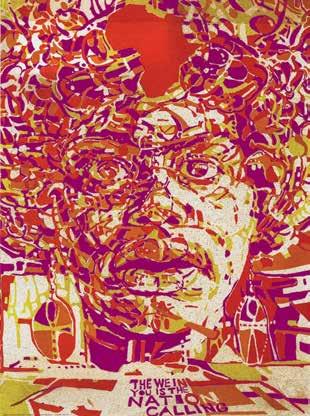
the images that Nelson published in Drum magazine, which was supported by UMass Amherst, could not be sold and were given to any and all free of charge.
It is Drum magazine that perhaps best demonstrates Nelson’s other defining characteristic: his dedication and commitment as a teacher. A reality is that time spent teaching others is time away from one’s own work. There was never a hint in Nelson’s words, attitude, or demeanor that suggested he resented spending time on others’ works rather than his own. One of the joys of my teaching career was to walk by Nelson’s drawing class and see students and their work covering every inch of the floor. I dreaded Nelson’s calling out, “John, come look at this.” At this point I reached for my checkbook, because Nelson knew I was a pushover when it came to buying works by his students, often their first sale. My prize is a rendering of Muhammad Ali’s KO of Ken Norton, done with chalk on brown paper grocery bags because the young white student couldn’t afford canvas or drawing paper. When Nelson painted murals, his students worked as collaborators, and you can see their various styles and images merged with his.
During our years at UMass Amherst, Nelson became the artist of choice for the covers of books published by his departmental colleagues. His rendering of the face of W.E.B. Du Bois graces the cover of the UMass Press edition of The Souls of Black Folk. When Sonia Sanchez, James Smethurst, and I asked Nelson to let us use Spirit Sister (1972) for the cover of SOS, we had no idea that the book would be so large that the press designer was able to reproduce Nelson’s image on the spine facing out.
A final thought. Nelson is known primarily as a painter, for his use of bold, vibrant rhythms and colors flowing across the wall or canvas. As I mentioned previously, he was also an excellent photographer, his camera seldom far from his reach. During the mid-1980s, James Baldwin joined our faculty. Jimmy fit right in and was an active presence on the third floor of New Africa House, where our offices were located. One day Nelson saw Jimmy and Max Roach standing in the hallway looking intently at each other and engaged in serious discussion. Nelson captured that moment and published it in Drum magazine. It is an extraordinary photograph that cries out for more attention to Nelson’s achievements as a photographer.
I studied art with Nelson Stevens at NIU, and I was delighted to have an instructor who looked like me and shared my cultural sensibilities. He had a natural teaching style and a knack for helping students connect ideas in developing compositions and themes.
Nelson was all about extending a student’s world. He led the Color Rappers in creating art for fundraisers so we could attend the annual National Conference of Artists. He was committed to helping younger artists network with the movers and shakers of the Black Arts movement.
Through Nelson, I learned that art is transformative in its effect and message. “The We in You Is the Nation Calling” and “I Am Because WE Are” are tenets I understand because of his commitment to community.
Nelson Stevens reviewing the production of one of his prints at Raven Fine Art Editions (Easton, PA)
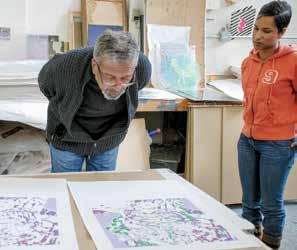
A Chinese proverb says that a child’s life is a blank slate on which every passerby makes a mark. It could also be said that this phenomenon happens throughout life.
During my childhood, there were some who planted seeds that grew into the artist Nelson Stevens. My godfather, Tom Randolph, was an architect who told my mother to put butcher paper on the walls and let me draw on that so that I would not make a mess. Once I was allowed to do that, I started experimenting with colors by melting crayons on the radiators. Also, I was instructed by my parents to draw and make greeting cards. They would say, “Someone is coming by, make them a card.”
After college, I married Rosalynn Joan Fairfax. Lynn graduated with honors from Walnut Hills High School, a well-known school of performing arts in Cincinnati, Ohio. She competed in many talent competitions, showcasing her skills in tap and ballet dancing. She appeared on Ted Mack’s Original Amateur Hour and ran for Miss Ohio University, but in those days, they weren’t inclined to award a Black woman a championship. She would have certainly won based purely on talent. I married way above my status. I am just a guy from Bed-Stuy in Brooklyn, whose father fixed refrigerators.
We got married in 1963. That same year, I got more fully involved in the world of music because of a good friend, Winston Willis, who opened a club called the Jazz Temple in Cleveland. I worked at the door of the club and became infused with the music of some of the giants in jazz, who made their marks on me. I saw Art Blakey, Wayne Shorter, and the young drummer Tony Williams. I had to be told to let Tony into the club because he was underage. He was only 17, but he was
the most talented drummer on the scene. Miles Davis came through right after he codified his quartet with Ron Carter. This was also the year I met Max Roach.
That same year, John Coltrane came through three times, and I caught all of his performances. He changed my life forever. Had I not seen him perform, I might have been satisfied with being a junior high school art teacher. Every night Coltrane appeared, he played the same tunes, but they sounded different from the night before. The tempo, the arrangement, his attitude, and his demeanor toward the songs were totally different every performance. When I heard how Coltrane explored his horn and got sounds no one else had achieved, it made me realize that I, myself, had just touched the surface of my area of expertise, which was art. This caused me to find ways to paint that no one else had. The only other musician that had that kind of an effect on me was Jimi Hendrix, who also approached his instrument distinctly differently at various times.
Ten years later I signed a contract at the University of Massachusetts Amherst with musicians Max Roach and Archie Shepp, playwright Paul Carter Harrison, and dancer Diana Ramos. We were to design a 21st-century aesthetic for African art. That dream fell apart, but some of us worked together later on different projects, although we never had the opportunity to work together on a single project.
When I first met Archie Shepp, I was enthralled. The year before, he had released an album called Attica Blues, which was dedicated to the 43 men that were killed in the historic uprising at Attica Prison in upstate New York. I loved the album and wanted to create a piece of artwork for his next release. He had seen my work and admired it. He told me to call and make arrangements with Ed Michel, an executive at Impulse Records in California. I called, and Mr. Michel informed me that Shepp had overstepped his bounds. They had staff artists and photographers in-house that did those things. I thanked him and hung up, disappointed and disillusioned. I called Shepp and told him about the phone call, and he told me to come to his house at noon the next day.
I arrived 15 minutes early dressed in shorts, a t-shirt, and sandals in direct contrast with Archie, who as always was dressed in a three-piece suit. He told me he had 15 minutes left of his circular breathing routine.
He started blowing bubbles through a straw into a halffilled glass of water. I watched for about five minutes, but since I had seen bubbles before, I decided to go outside. I smoked a cigarette and returned when he finished. He served tea, and we told a couple of jokes and stories about our kids. I petted his dog, Juba, and I thought to myself, “He is letting me down for a soft landing.”
Then he picked up the phone, called Ed Michel, and said, “Hi Ed, how are you doing? How are the kids? Everything is fine? Yeah, everything is good. Regarding Professor Stevens. Do you want to release the album? Here, speak to Professor Stevens, make the arrangements.”
It was the best introduction I ever had. “Do you want to release the album?” That was it. He said, “Do you want to release the album.” There was a threat there, there was friendship, there was all kinds of stuff, but the message was delivered. “Here, speak to Professor Stevens.” After that I got three contracts with Impulse Records. Two for Archie, There's a Trumpet in My Soul and The Cry of My People, and one for another good friend, Marion Brown. I have been grateful to Archie Shepp ever since.
Incidents that taught me more about friendship and about spirituality involved my good friend Max Roach. One night after coming home from my studio at UMass, my wife, Lynn, complained of a pain. By the next morning, the pain had become so intense that we went to

the hospital, where she was operated on that same day after being diagnosed with renal cell carcinoma. Max Roach stayed by my side for 24 hours in the hospital while other people came and went. He told me stories about the deaths of Richie Powell and Clifford Brown, who had died in car accidents. He talked about the acclaimed Freedom Now Suite that he composed and all kinds of things to keep me from worrying about Lynn.
About six months later, I was backstage with Max’s trumpet player, Cecil Bridgewater, who introduced me to Jessye Norman, the great classical and opera vocalist, saying, “This is a guy that Max really loves, he cancelled an engagement to stay with him while his wife was in surgery. And you know how Max hates to cancel engagements. He never wanted to be confused with Miles, who always cancelled gigs.” I said, “Sorry I made you miss a pay date.” He replied, “Oh, don’t worry about that, we always get paid.” That meant that in order to stay with me, Max paid three musicians for their time and never breathed a word to me. This created a new standard for me in terms of understanding real friendship.
In 1977, Lynn’s condition had worsened to the point where I was basically her nurse. Friends of hers from all over the country came and spent weeks at a time with her. During these times, they would tell me to get lost, to go to my studio or somewhere. Eventually, she became so ill that she stopped accepting company. When Max asked if he could visit her, I told him I would have to ask her. When I told her he wanted to see her, she agreed to let him come. He came by two days later for about an hour. It took an hour and a half to get her situated in bed to be comfortable enough to receive company. He came in and I served orange juice to them and then went out on the porch. Every now and then I heard a little laughter, and I knew they were getting along great. A little later, I checked on them and she said she was getting tired, so Max left. Max’s favorite musician was Duke Ellington, who was a very spiritual musician, and Max exhibited the same spirituality in a letter that arrived three days later in the mail. I don’t remember the whole letter, but the first sentence said, “Dearest Lynn, thank you for allowing me to witness you in your Christlike suffering.” It seemed like she had given up on me, on the bible, and on many other things, but that letter never left her bed. She was buried with it.
“ When I heard how Coltrane explored his horn and got sounds no one else had achieved, it made me realize that I, myself, had just touched the surface of my area of expertise, which was art. This caused me to find ways to paint that no one else had.
—NELSON STEVENS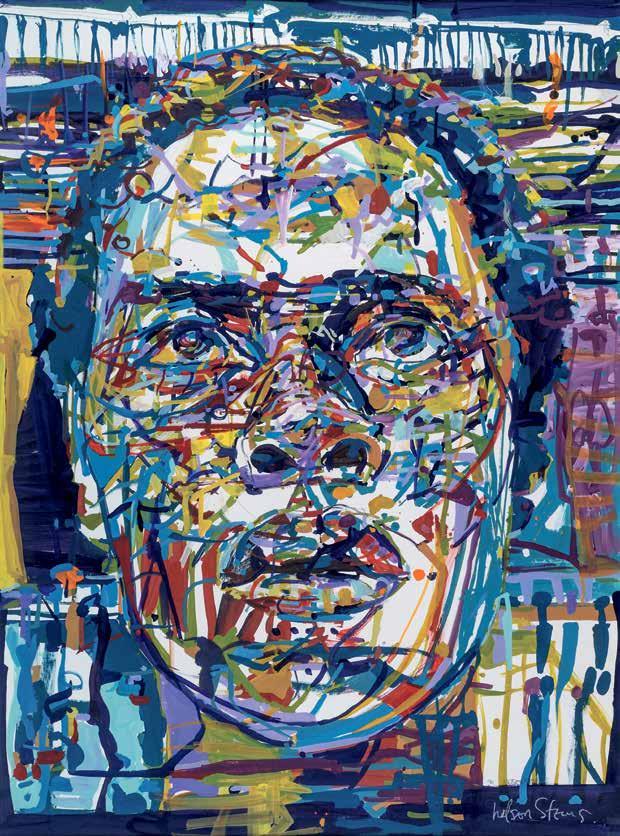
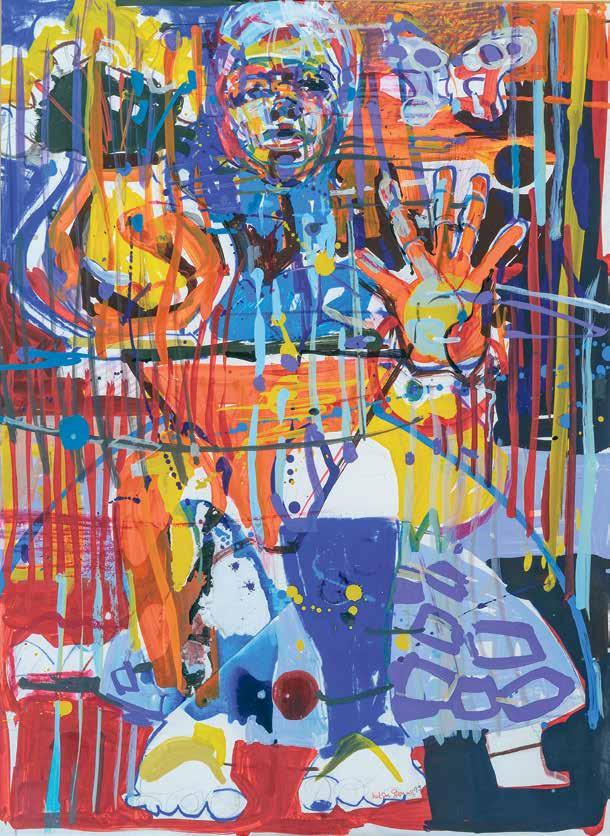
Untitled (Red Abstract) 1960 acrylic on canvas 20 x 32 inches
Collection of Gwendolyn Wilder
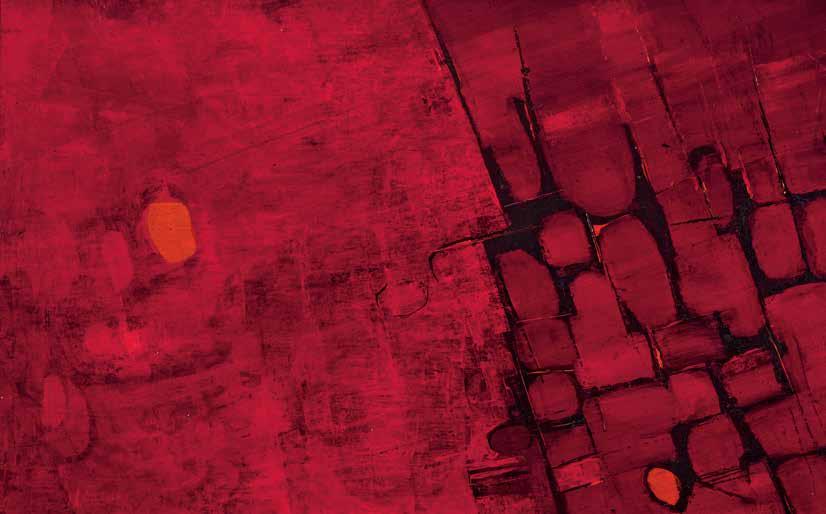

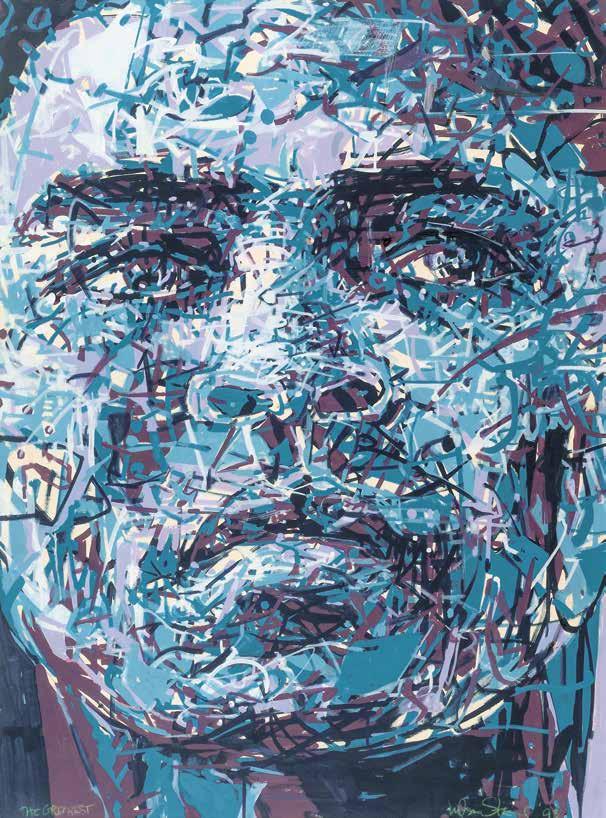
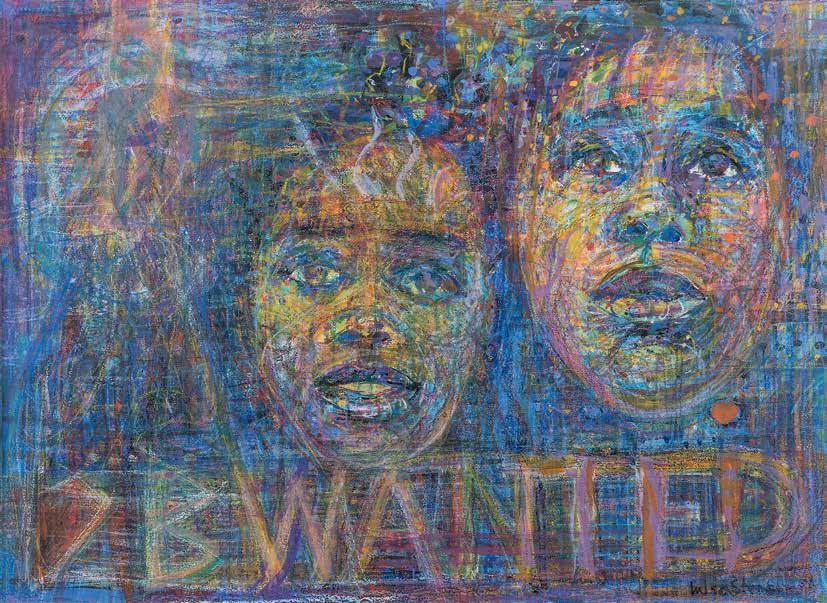
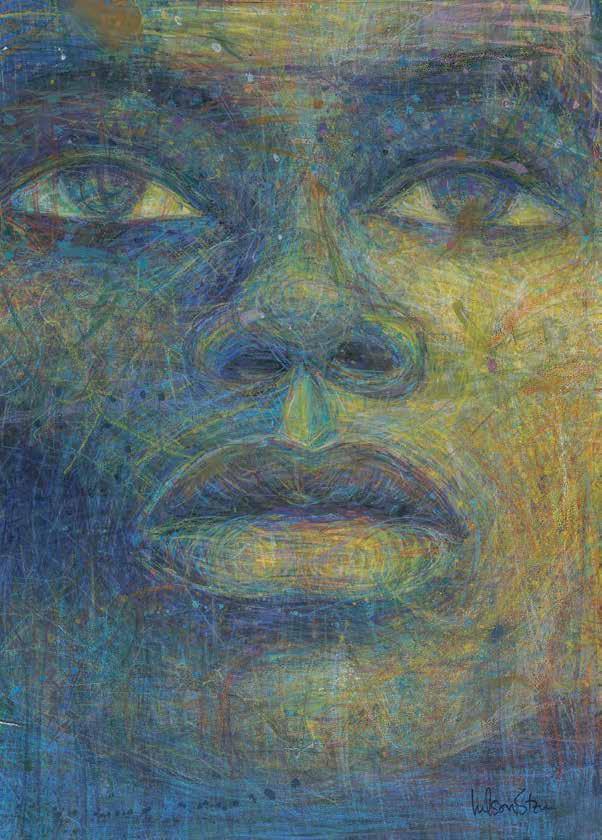
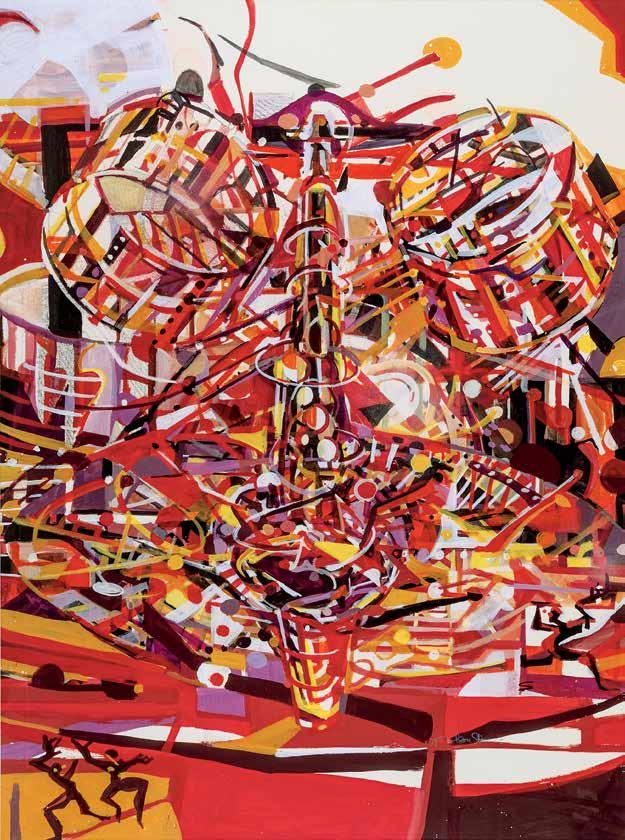

Untitled 1979 acrylic on wood panel 80 x 24 inches Courtesy of the artist’s estate




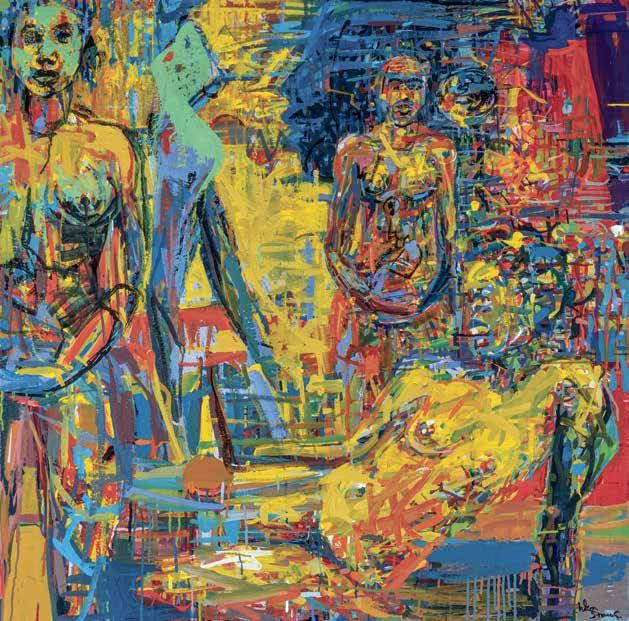
Heroic 1 n.d. acrylic on canvas 39 x 39 inches
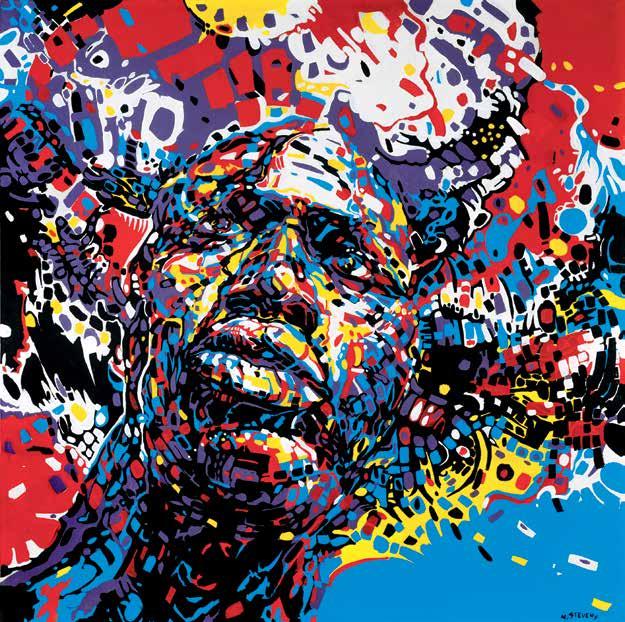
And His Name Is 1995
colored pencil and crayon on paper 30 x 36 inches Courtesy of the artist’s estate

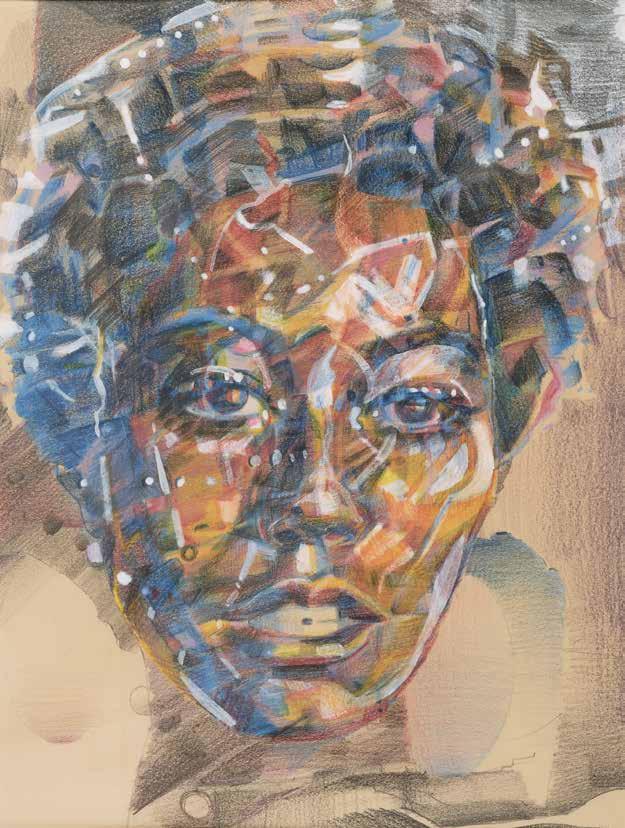
Untitled n.d. acrylic on wood panel 79 x 36 inches Courtesy of the artist’s estate
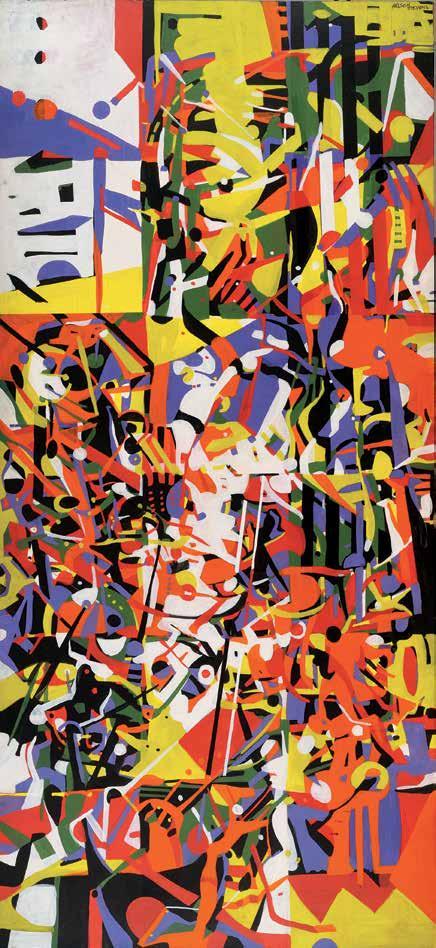



40 x 30 inches
Courtesy
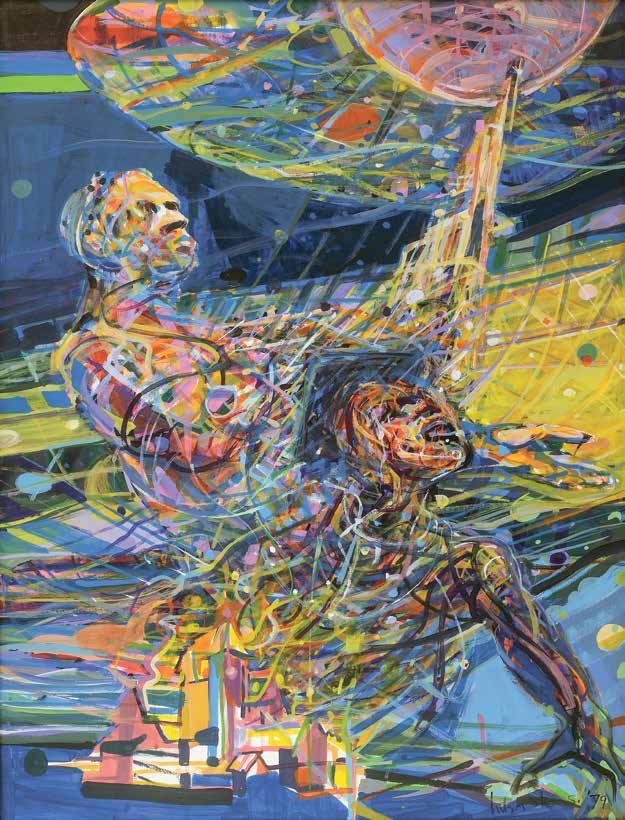

40 x 30 inches
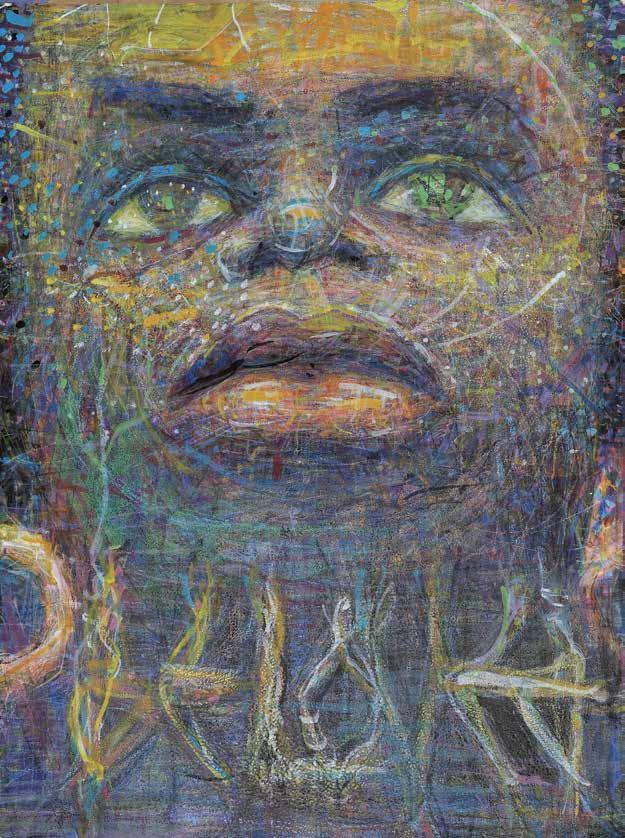


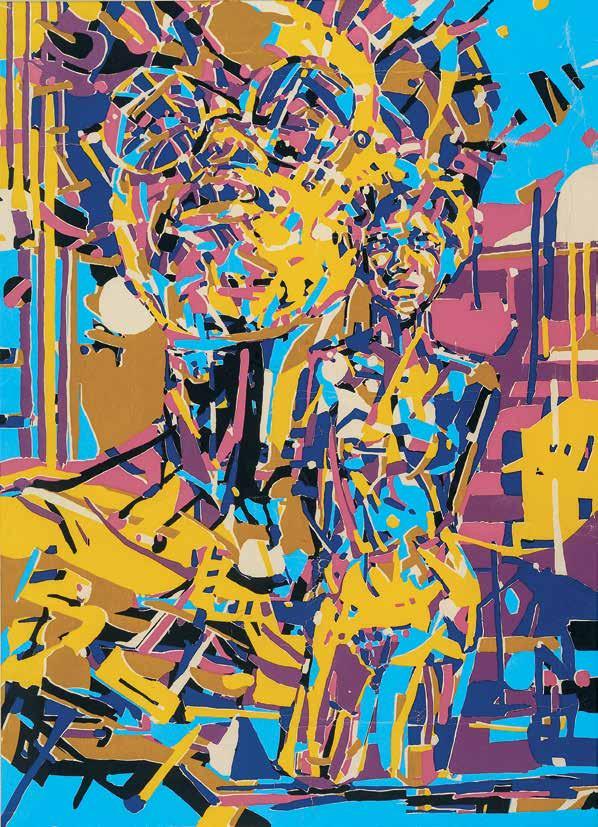
40 x 30 inches
Courtesy

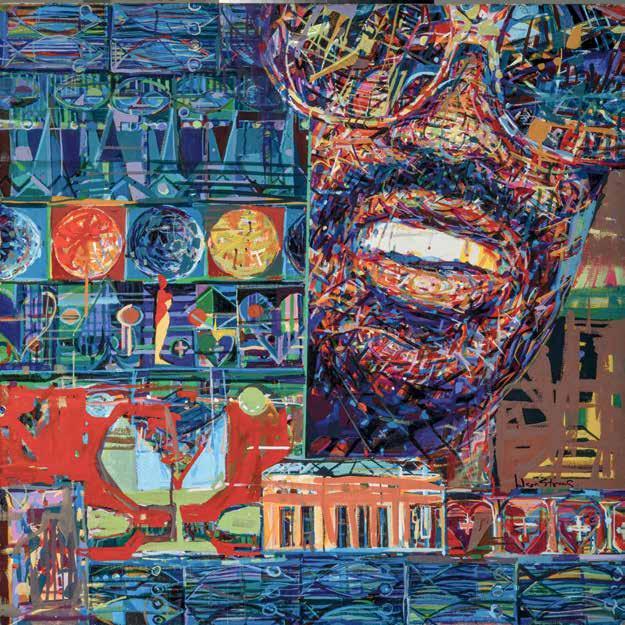

Distant Lover n.d. acrylic on board 78 x 30 inches Collection of Augusta Savage Gallery, University of Massachusetts Amherst
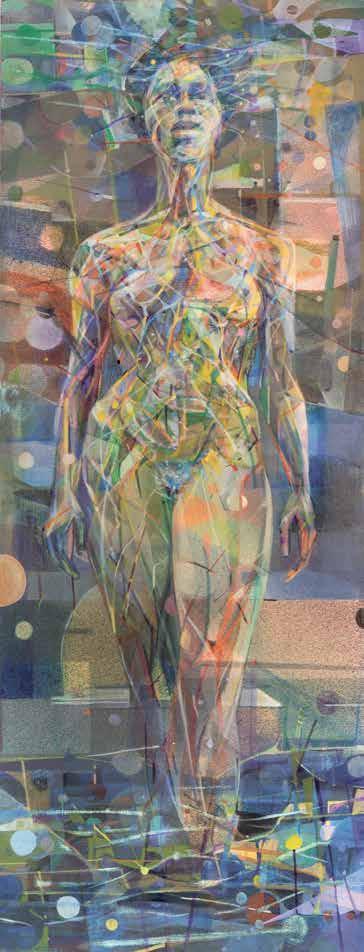
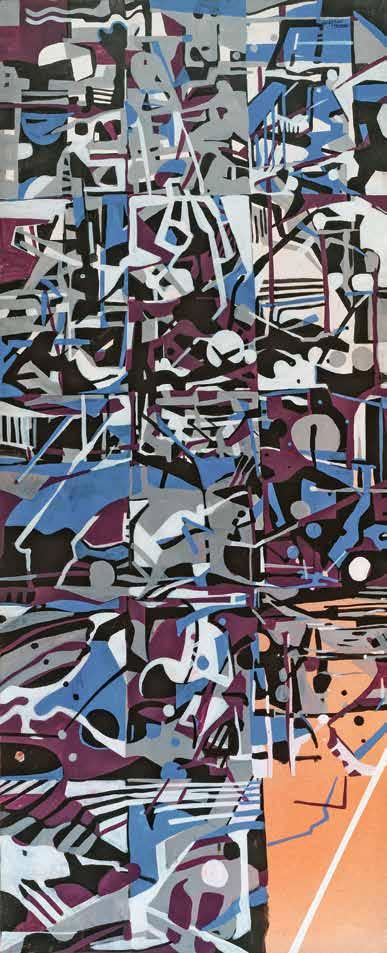 Jubilee Songs of Nirvana series n.d. acrylic on wood panel 79 x 32 inches Courtesy of the artist’s estate
Jubilee Songs of Nirvana series n.d. acrylic on wood panel 79 x 32 inches Courtesy of the artist’s estate
Jubilee:
73 x 36 inches

Courtesy of the artist’s estate
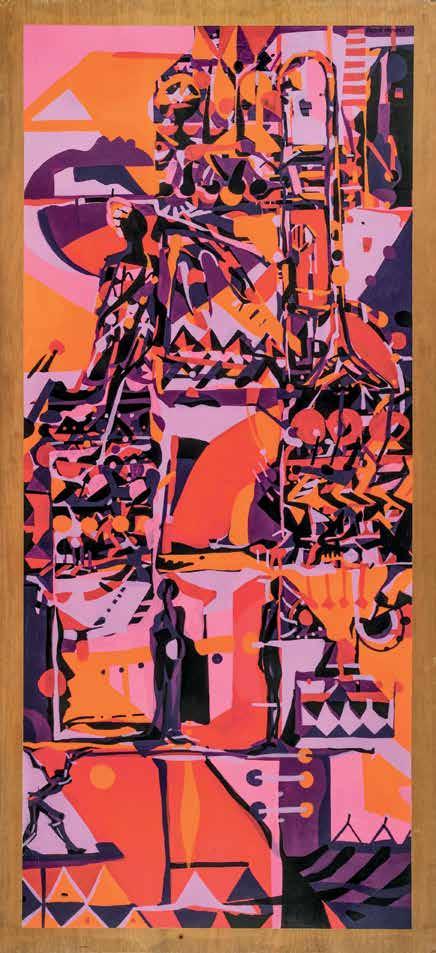
Jubilee: Magic Music
Songs of Nirvana series n.d. acrylic on wood panel 78 x 36 inches

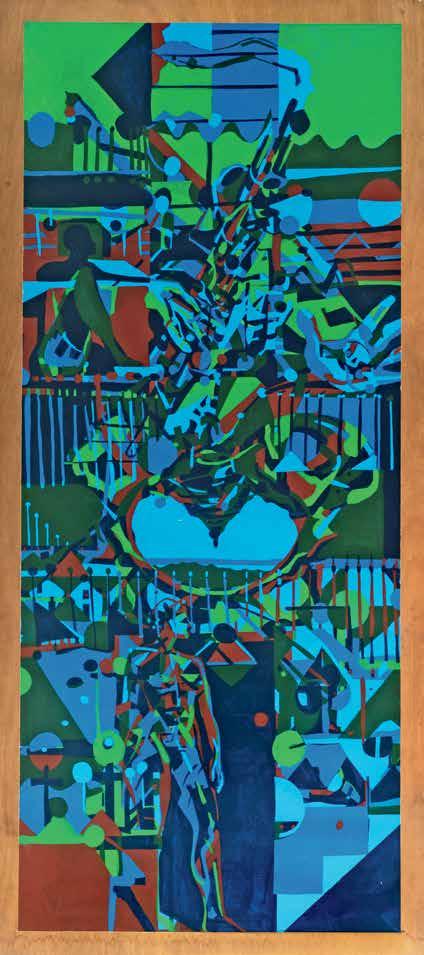
Courtesy of the artist’s estate
Jubilee: Shango Dreams
Songs of Nirvana series n.d. acrylic on wood panel 80 x 36 inches
Courtesy of the artist’s estate
Primary Force #2 1977
acrylic on wood panel 78 x 30 inches
Courtesy of the artist’s estate


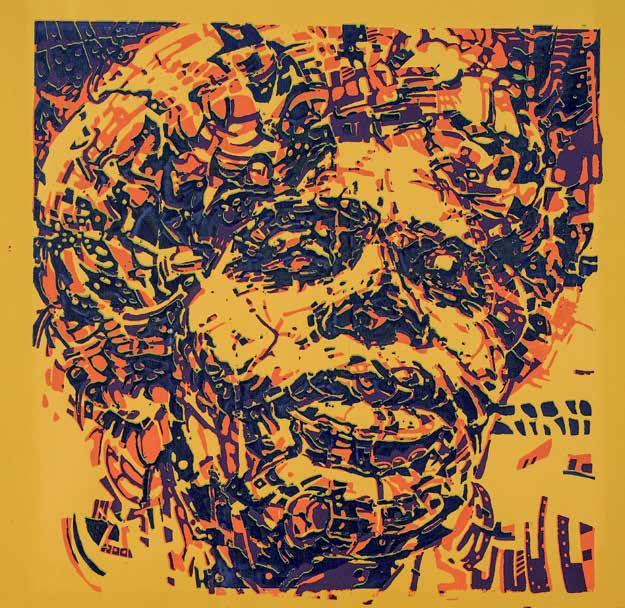

And His Name Is 1995
colored pencil and acrylic on black Arches Rives paper
43½ x 53¾ inches Courtesy of the artist’s estate and Galerie Myrtis


Musicians Totem 1975–76 acrylic on wood panel 78 x 36 inches
Courtesy of the artist’s estate
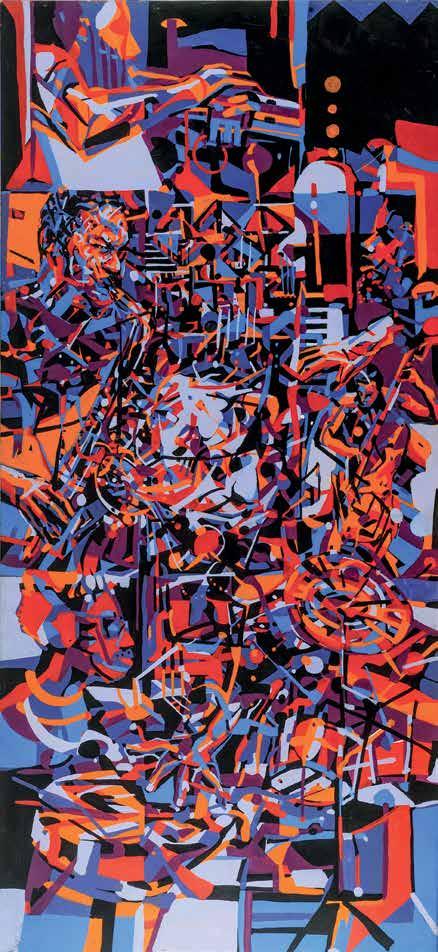
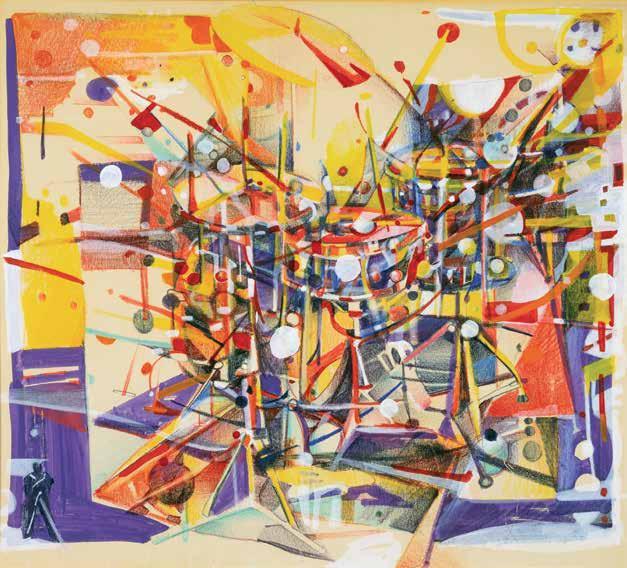
Child Jesus 1994 colored pencil with acrylic on paper 27 x 26 inches

Courtesy of the artist’s estate
Untitled 1990s acrylic with colored pencil on paper 31 x 31½ inches
Courtesy of the artist’s estate
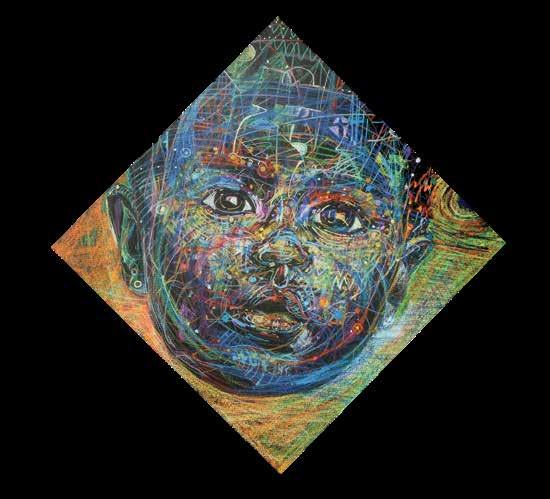
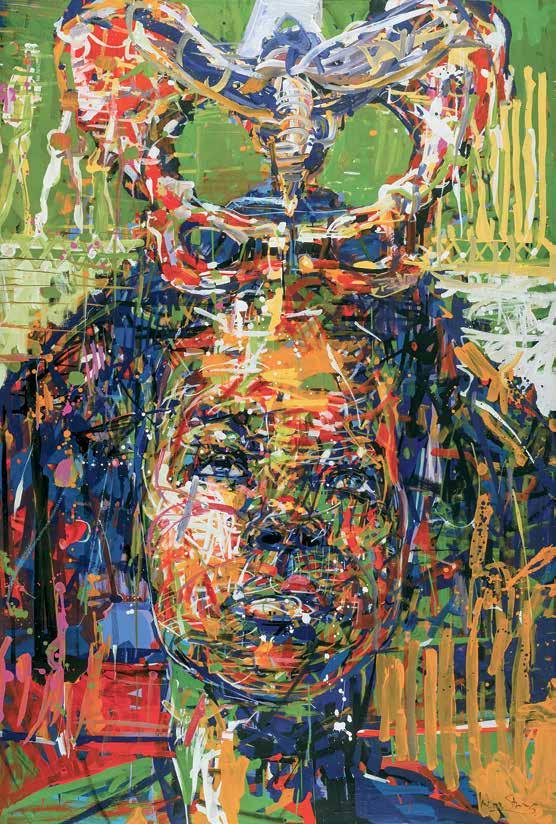
Prophet 1978 acrylic on board 40 x 30 inches
Collection of Dr. Gregory and Katherine Demopulos

Untitled 1988 collage and color pencil 197⁄8 x 26 inches Collection of Napoleon Jones-Henderson of the Research Institute of African and African Diaspora Arts, LLC
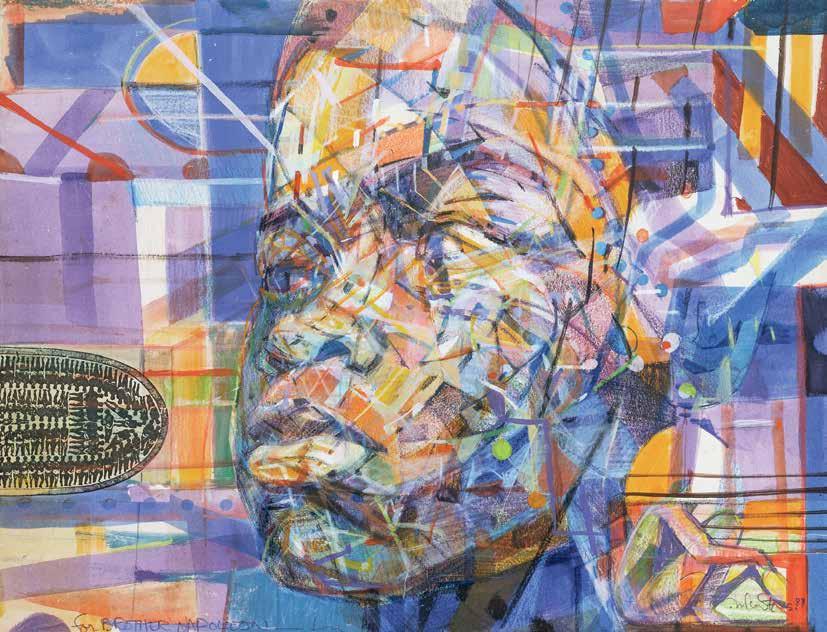
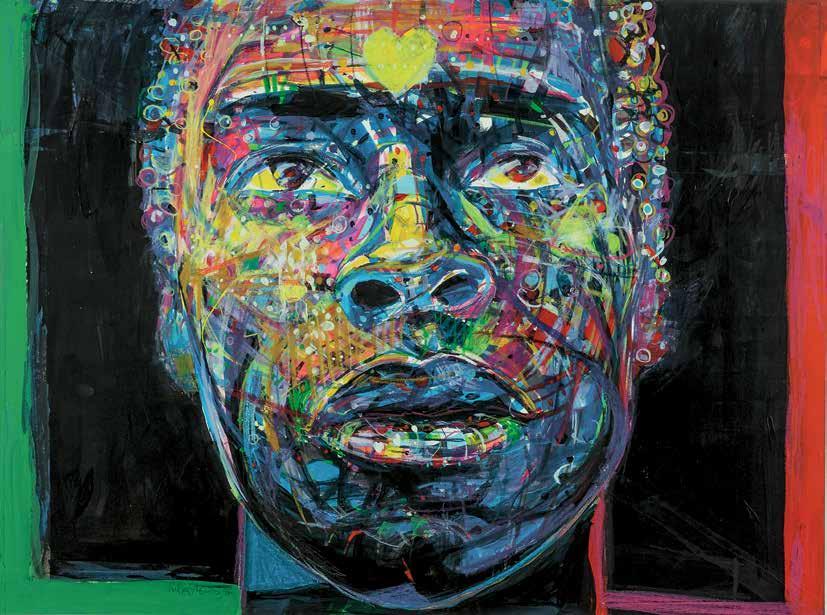
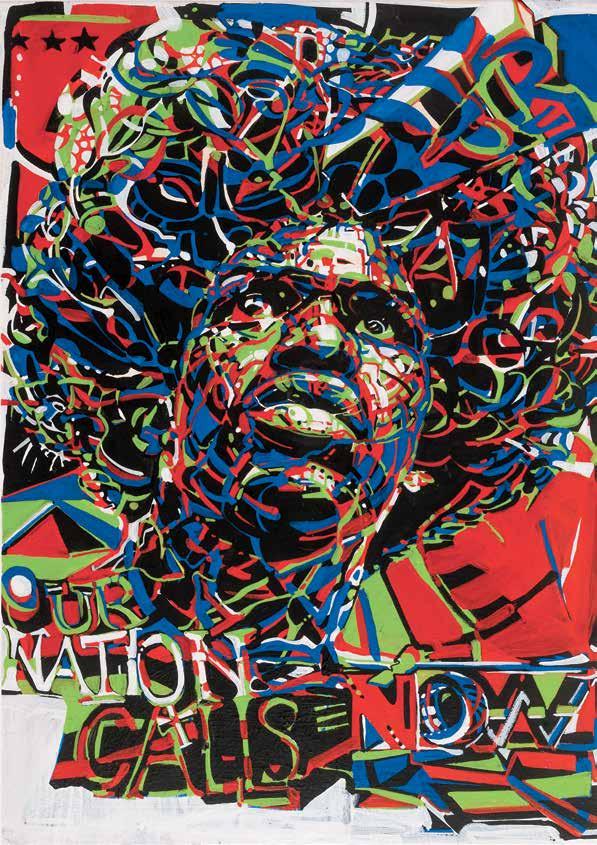
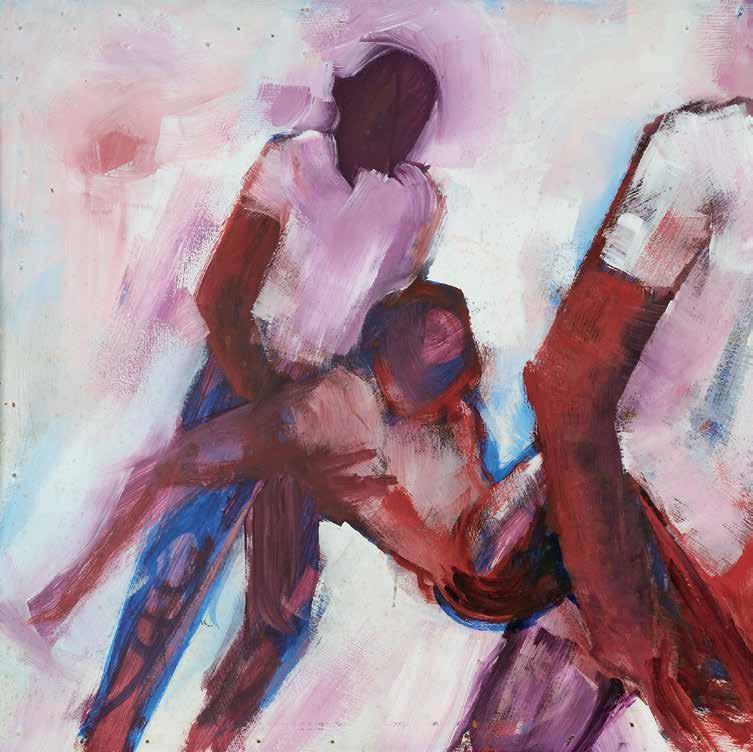
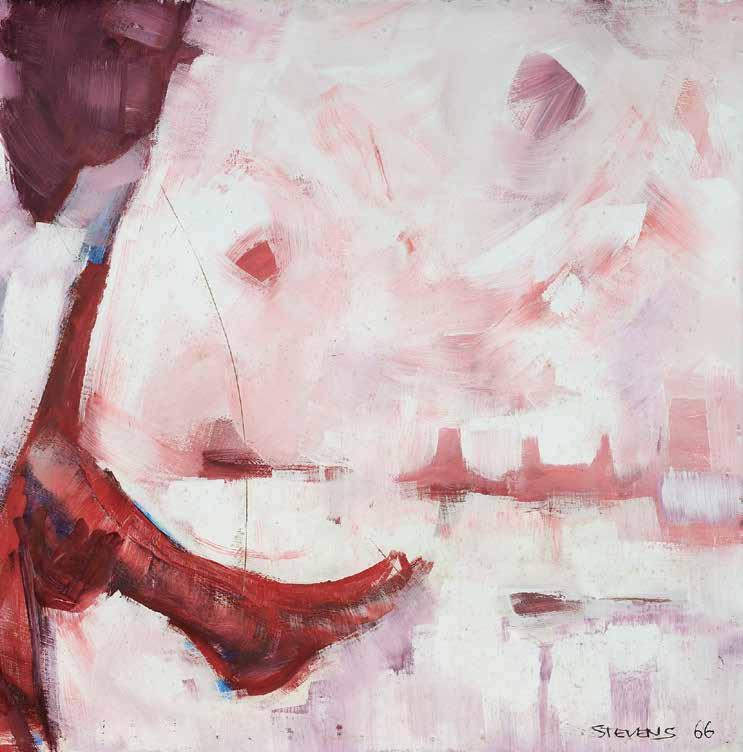
Untitled (Bob Marley) 1979 cut paper collage and acrylic on museum board 30 x 24 inches
Collection of Ellie Meek Tweedy

Stevie’s Smile late 1980s acrylic on board 39½ x 30 inches Courtesy of the artist’s estate
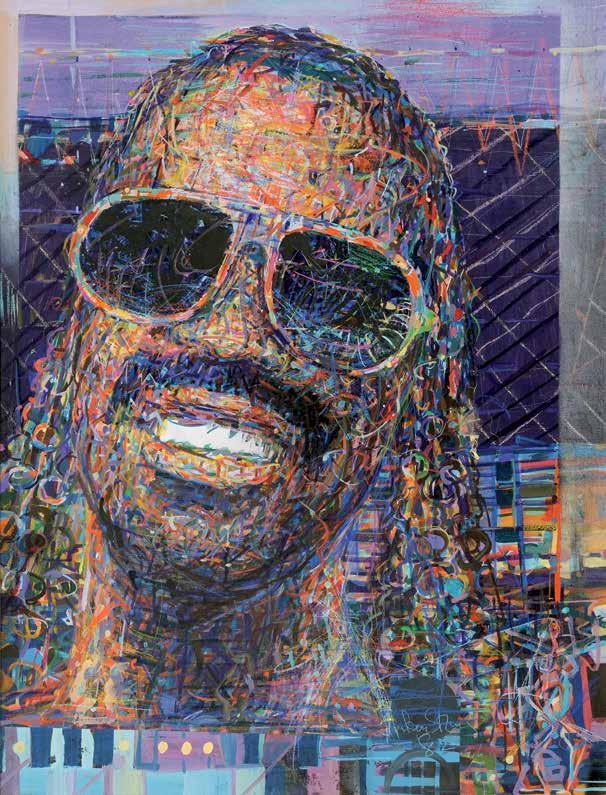
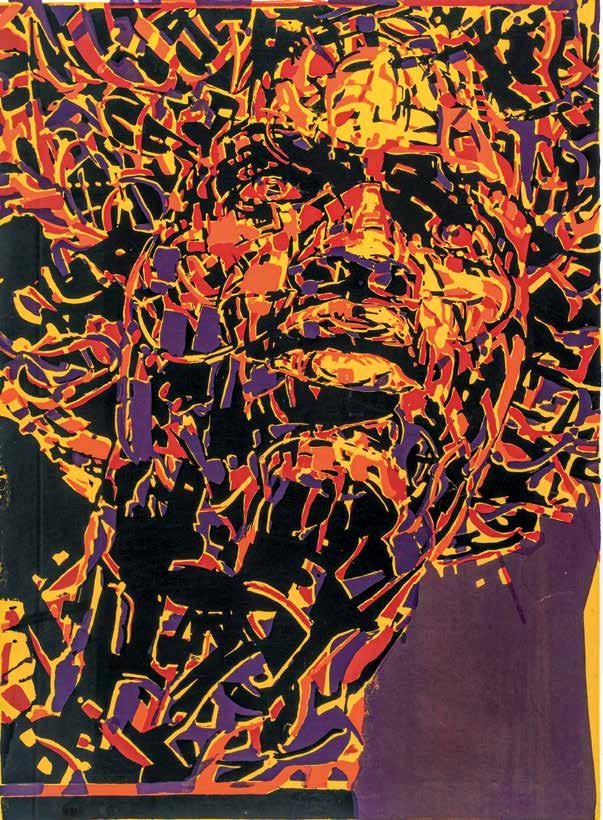
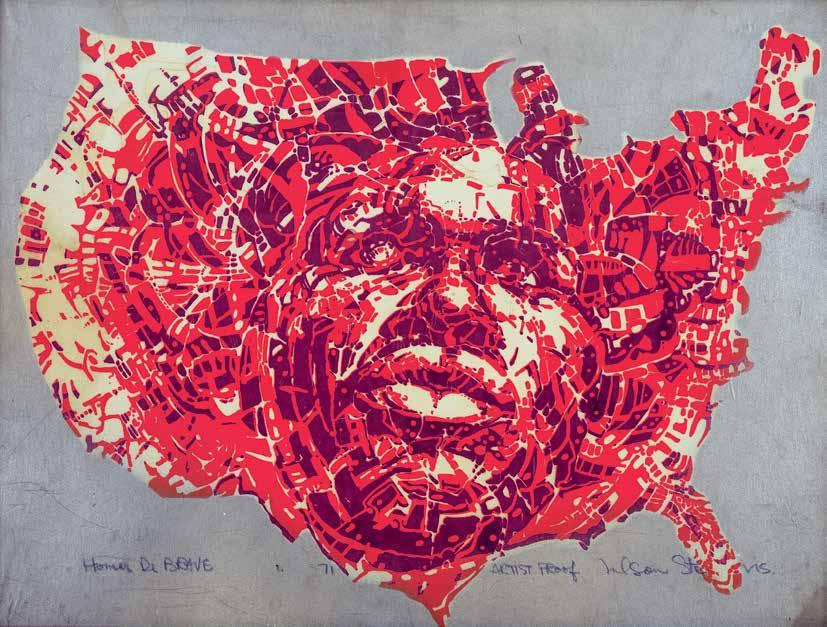
Liberation Poster VII n.d.
colored felt-tip pen on paper 22 x 12 inches
Courtesy of the artist’s estate
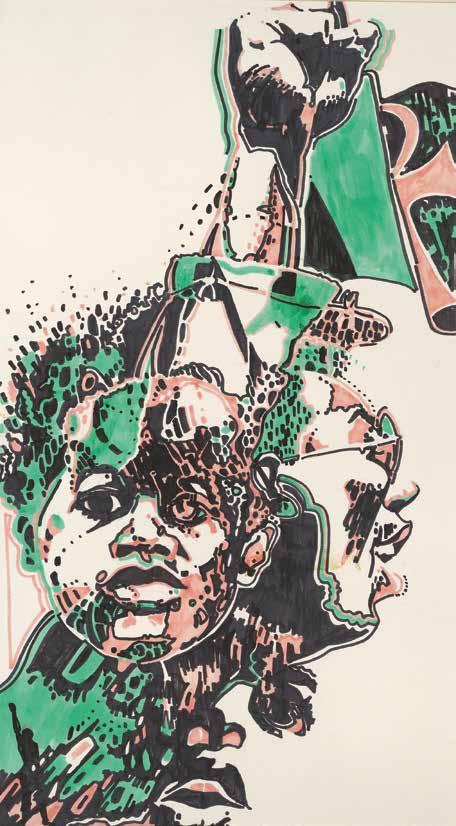
As King Speaks n.d. pen and ink on paper 15 x 12 inches Collection of Karen and Kevin Cole

The We in You Is the Nation Calling n.d.
silkscreen 23 x 17½ inches Collection of Donnell and Dorothea Walker
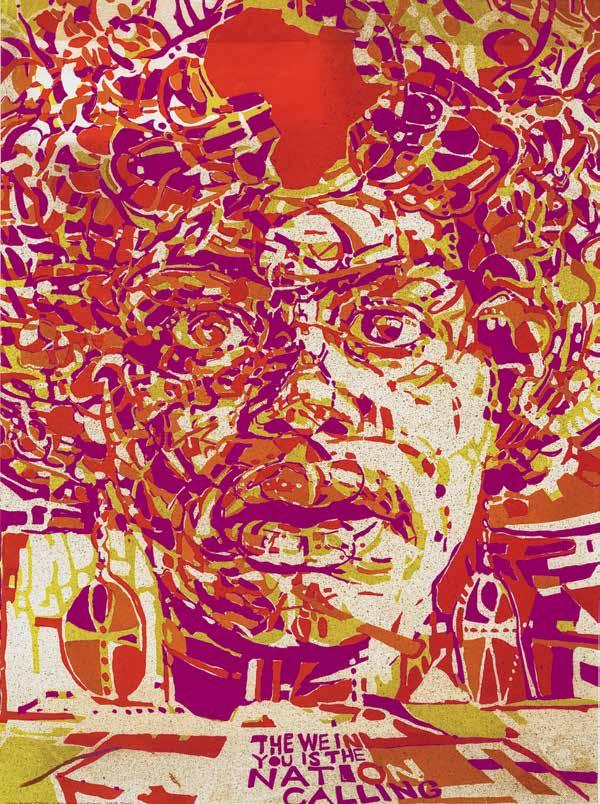
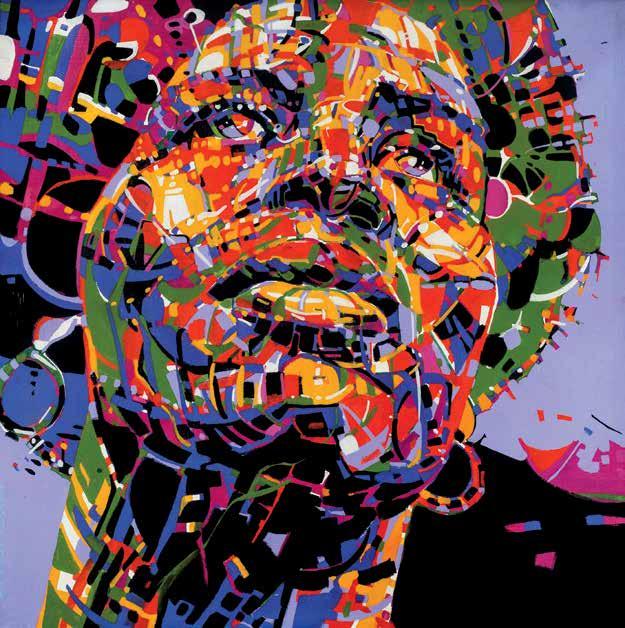
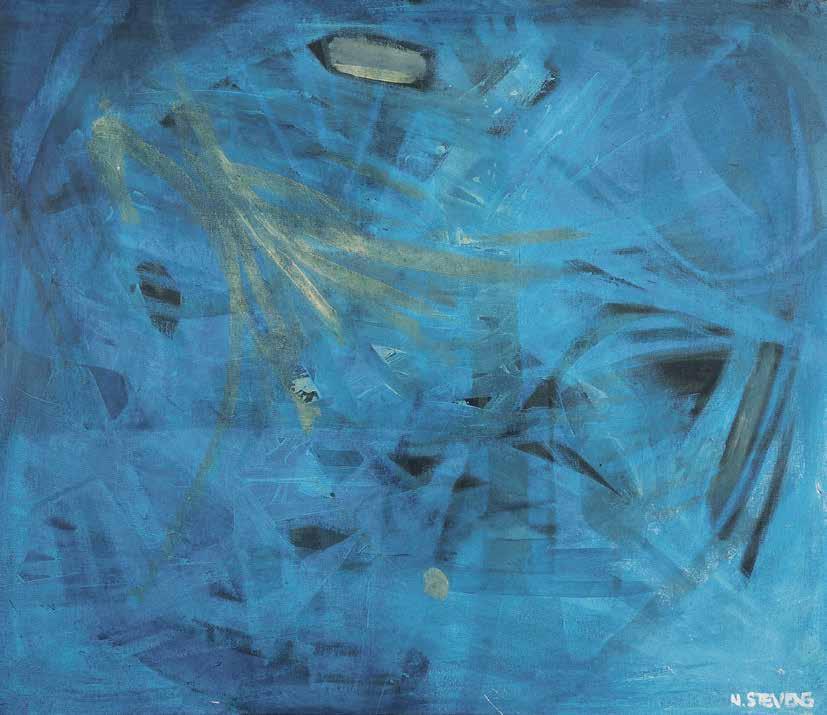
Untitled 1977 acrylic on wood panel 80 x 24 inches Courtesy of the artist’s estate

Sister
acrylic on board 36 x 30 inches
Courtesy of the artist’s estate and Galerie Myrtis
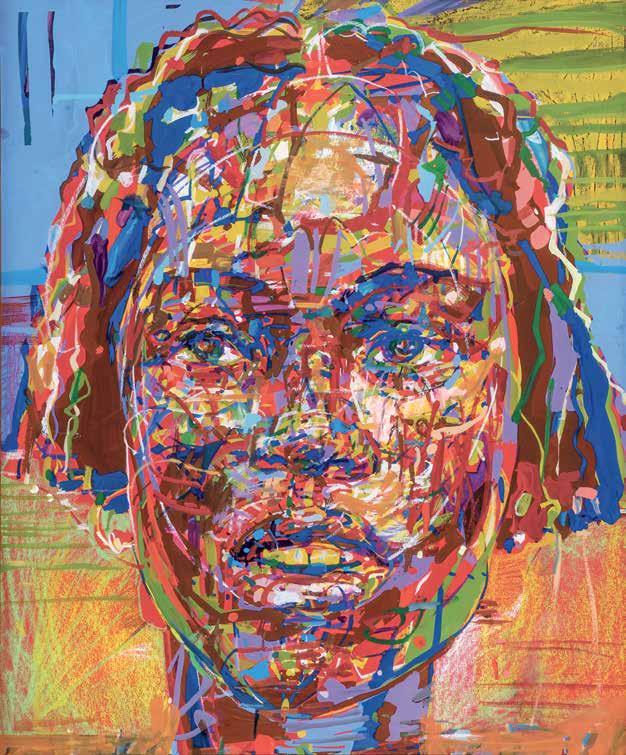
Blessing Love Supreme n.d. silkscreen 17¼ x 16¼ inches
Collection of Napoleon Jones-Henderson of the Research Institute of African and African Diaspora Arts, LLC

Wanted
c. 1996
acrylic and colored pencil on Arches Rives paper 22 x 30 inches
Courtesy of the artist’s estate and Galerie Myrtis
8th Wonder of the World 1982
gouache and acrylic on museum board 40 x 30 inches
Courtesy of the artist’s estate and Kravets Wehby Gallery Adoration 1990s colored pencil on board 38½ x 27 inches
Collection of Nadya Stevens
And His Name Is 1995 colored pencil and acrylic on black Arches Rives paper 43½ x 53¾ inches
Courtesy of the artist’s estate and Galerie Myrtis
And His Name Is 1995 colored pencil and crayon on paper 30 x 36 inches
Courtesy of the artist’s estate
And in the Beginning 1979
mixed media on board 34 x 34 inches
Collection of Christa and Michael Brinson
As King Speaks n.d. pen and ink on paper 15 x 12 inches
Collection of Karen and Kevin Cole
Being and Becoming c. 1969 silkscreen 15 x 14 inches
Collection of Schyleen Qualls
Beloved Schyleen c. 1970 acrylic on paper 19 x 15 inches
Collection of Schyleen Qualls
Beloved Spirit Sister n.d. acrylic and colored pencil on board 40 x 30 inches
Courtesy of the artist’s estate
Blessing Love Supreme n.d. silkscreen 17¼ x 16¼ inches
Collection of Napoleon Jones-Henderson of the Research Institute of African and African Diaspora Arts, LLC
Bonnie Hoodoo Bone Boogie series 1989 acrylic on canvas 68 x 46 inches
Courtesy of the artist’s estate and Galerie Myrtis
Booker T. in Tuskegee c. 1979 acrylic on board 40 x 30 inches
Courtesy of the artist’s estate and Galerie Myrtis
Child Jesus 1994 colored pencil with acrylic on paper 27 x 26 inches
Courtesy of the artist’s estate
Distant Lover n.d. acrylic on board 78 x 30 inches
Collection of Augusta Savage Gallery, University of Massachusetts Amherst
Eighth Wonder 1980 oil on canvas 39½ x 39½ inches Collection of Eric Key
The Greatest (Muhammad Ali) n.d. serigraph 41½ x 29½ inches
Collection of Afro-American Studies, University of Massachusetts Amherst
Heroic 1 n.d. acrylic on canvas 39 x 39 inches
The John and Susan Horseman Collection on behalf of Carol Braddock
Homage to the Great Max Roach 1979 mixed media on board 40 x 30 inches
Collection of Donnell and Dorothea Walker
Homer da Brave 1971 screenprint artist’s proof 21 x 28 inches
Collection of Arlene TurnerCrawford
Imani Impulse 1974 silkscreen edition 4 of 100 38 x 26 inches
Collection of Arlene TurnerCrawford
Jesse 1979
mixed media on board 40 x 30 inches
Collection of Donnell and Dorothea Walker
Jubilee Songs of Nirvana series n.d.
acrylic on wood panel 79 x 32 inches
Courtesy of the artist’s estate
Jubilee Songs of Nirvana series 1977 acrylic on wood panel 78 x 36 inches
Courtesy of the artist’s estate
Jubilee: I Hear You Miles Songs of Nirvana series 1977 acrylic on wood panel 73 x 36 inches
Courtesy of the artist’s estate
Jubilee: Magic Music Songs of Nirvana series n.d.
acrylic on wood panel 78 x 36 inches
Courtesy of the artist’s estate
Jubilee: Shango Dreams Songs of Nirvana series n.d.
acrylic on wood panel 80 x 36 inches
Courtesy of the artist’s estate
Juju Lover n.d. serigraph 17 x 16 inches
Courtesy of the artist’s estate
Liberation Poster VII n.d.
colored felt-tip pen on paper 22 x 12 inches
Courtesy of the artist’s estate
Max Roach’s Drum Set n.d.
colored pencil and acrylic on paper 24 x 21½ inches
Collection of Iris K. Fairfax
Music on My Mind n.d. collage 20 x 18 inches
Courtesy of the artist’s estate
Musicians Totem 1975–76 acrylic on wood panel 78 x 36 inches
Courtesy of the artist’s estate
My Beloved Son 1995 mixed media on paper 31 x 31 inches
Collection of Christa and Michael Brinson
Original New Man 1969 acrylic on museum board 26½ x 18 inches Collection of Peter Fischer
Our Nation Calls Now c. 1971–72 acrylic on paper 30 x 20 inches
Collection of Willis “Bing” and Audrey Davis
Primal Force 1974 silkscreen artist's proof 32 x 24 inches
Collection of Linda Silva Thompson, PhD
Primal Force 2019 serigraph edition 4 of 86 24 x 22 inches
Private collection
Primary Force #2 1977 acrylic on wood panel 78 x 30 inches
Courtesy of the artist’s estate
Prophet 1978 acrylic on board 40 x 30 inches
Collection of Dr. Gregory and Katherine Demopulos
Rebellion 1966 oil and house paint on board 24 x 48½ inches Collection of Charlotte L. Horton
Rhythming (Nude Figure) 1984 colored pencil and acrylic on paper 22½ x 30 inches
Courtesy of the artist’s estate
Sister Mine: Sister, Will You Stand with Me c. 1994 acrylic on board 36 x 30 inches
Courtesy of the artist’s estate and Galerie Myrtis
Sister, Will You Stand with Me n.d. acrylic and colored pencil on board 30 x 40 inches
Collection of Nadya Stevens
So We Too n.d.
acrylic on canvas 29½ x 39 inches
Collection of Eric and Rhea Bailey
So We Too 1979 acrylic on museum board 30 x 40 inches
Collection of Dolka and George Gaitanaris
Spirit Brother (Jimi Hendrix) 1960s
colored pencil on paper 23 x 19 inches
Collection of Dolka and George Gaitanaris
Spirit Sister 1971 acrylic on canvas 39 x 39 inches
Collection of Christa and Michael Brinson Spirit Sister 2013 serigraph 18 x 18 inches
UMGC Permanent Collection
The Doris Patz Collection of Maryland Artists
Stevie Wonder 1979 mixed media on board 36 x 21 inches
Collection of Christa and Michael Brinson
Stevie Wonder 1982 mixed media 30 x 26 inches
UMGC Permanent Collection
The Doris Patz Collection of Maryland Artists
Stevie’s Smile late 1980s acrylic on board 39½ x 30 inches
Courtesy of the artist’s estate
UHURU n.d. silkscreen 40 x 30 inches
Collection of Jae and Wadsworth Jarrell
Untitled n.d. acrylic on wood panel 79 x 36 inches
Courtesy of the artist’s estate
Untitled 1977 acrylic on wood panel 80 x 24 inches
Courtesy of the artist’s estate Untitled 1979 acrylic on wood panel 80 x 24 inches
Courtesy of the artist’s estate
Untitled 1980 oil on canvas 47 x 41 inches
Collection of Eric Key Untitled 1988 collage and color pencil 197⁄8 x 26 inches
Collection of Napoleon Jones-Henderson of the Research Institute of African and African Diaspora Arts, LLC
Untitled 1990s acrylic with colored pencil on paper 31 x 31½ inches Courtesy of the artist’s estate Untitled 1993 mixed media 24 x 18 inches
Collection of Linda Silva Thompson, PhD
Untitled (Blue) 1964 acrylic on canvas 47 x 41 inches
Collection of Gwendolyn Wilder
Untitled (Bob Marley) 1979 cut paper collage and acrylic on museum board 30 x 24 inches
Collection of Ellie Meek Tweedy
Untitled (Red Abstract) 1960 acrylic on canvas 20 x 32 inches
Collection of Gwendolyn Wilder
The We in You Is the Nation Calling n.d. silkscreen 23 x 17½ inches Collection of Donnell and Dorothea Walker
Wholy Mother and Child n.d. acrylic on paper 30 x 28 inches
Collection of Brenda P. DelGado
Gregory Fowler, PhD President University of Maryland Global Campus
Myrtis Bedolla, Chair Owner and Founding Director Galerie Myrtis
Schroeder Cherry, EdD, Vice Chair
Artist and Adjunct Professor of Museum Studies Morgan State University
Eva J. Allen, PhD, Honorary Member Art Historian
Joan Bevelaqua Artist and Adjunct Professor of Art University of Maryland Global Campus
James “Buzz” Cusack Jr. Owner and President Charles Theatre and Senator Theatre
Seble Dawit, Esq. Director and Associate Professor Peace Studies, Goucher College
Nina C. Dwyer
Artist and Adjunct Professor of Art Montgomery College
Karin Goldstein, Honorary Member Collector and Patron of the Arts
Juanita Boyd Hardy, Honorary Member Director, Millennium Arts Salon Managing Principal, Tiger Management Consulting Group, LLC
Sharon Smith Holston, Honorary Member Artist’s Representative and Co-Owner, Holston Originals
Eric Key Director, Arts Program University of Maryland Global Campus
Thomas Li, Honorary Member Chairman and Chief Executive Officer, Ret. Biotech Research Labs, Inc.
David Maril, Honorary Member Journalist President, Herman Maril Foundation
Amy Eva Raehse
Executive Director, Vice President, and Partner Goya Contemporary Gallery
Christopher Shields Director, Business Operations NASDAQ.com
Barbara Stephanic, PhD, Honorary Member Professor Emerita of Art History College of Southern Maryland
Dianne A. Whitfield-Locke, DDS Collector and Patron of the Arts Owner, Dianne Whitfield-Locke Dentistry
Sharon Wolpoff Artist and Owner Wolpoff Studios
The UMGC Arts Program is dedicated to furthering the university’s objectives by creating a dynamic environment in which our diverse constituents, including students and the general public, can study and learn from direct exposure to our art collections, exhibitions, and educational programs.
University of Maryland Global Campus was founded 75 years ago specifically to serve the higher education needs of working adults and servicemembers. Today, UMGC continues its global tradition with online and hybrid courses, more than 175 classroom and service locations worldwide, and more than 125 degrees and certificates backed by the reputation of a state university and the University System of Maryland. For more information, visit umgc.edu.
Since 1978, UMGC has proudly shown works from a large collection of international and Maryland artists at its headquarters in Adelphi, Maryland, a few miles from the nation’s capital. Through its Arts Program, the university provides a prestigious and wide-ranging forum for emerging and established artists and brings art to the community through special exhibitions and its own collections, which have grown to include more than 2,900 pieces of art.
Artworks are on display throughout the College Park Marriott Hotel & Conference Center and the Administration Building in Adelphi. The main, lower-level gallery in Adelphi is open to the public from 9 a.m. to 9 p.m. seven days a week, and the Leroy Merritt Center for the Art of Joseph Sheppard is open to the public from 9 a.m. to 7 p.m. seven days a week. More than 75,000 students, scholars, and visitors come to the Adelphi facilities each year.
Located in the heart of downtown Springfield, Massachusetts, the Springfield Museums is a multidisciplinary, nonprofit organization that comprises five separate museums representing the disciplines of art, history, and science and including an outdoor sculpture garden. The museums were founded in 1857 with the formation of the City Library Association and have evolved with each new generation of visitors. The Springfield Museums’ first freestanding museum building, the George Walter Vincent Smith Art Museum, opened to the public in 1896 as a space devoted to sharing the beauty of global cultures with the people of the city. This initial focus has expanded to include themes of innovation, STEM learning, and literacy acquisition across many disciplines, all intertwined with playful, transformative, and inspiring learning. Today, more than 450,000 annual visitors benefit from permanent collections, changing exhibitions, educational programs, and special events at the George Walter Vincent Smith Art Museum, the Michele and Donald D’Amour Museum of Fine Arts, the Springfield Science Museum, the Lyman and Merrie Wood Museum of Springfield History, the Amazing World of Dr. Seuss Museum, and the Dr. Seuss National Memorial Sculpture Garden.
Director, Arts Program: Eric Key
Curator: Treston Sanders
Editors: Sandy Bernstein, Beth Butler, and Barbara Reed
Senior Web and Graphic Design Manager: Olya Kalatsei
Senior Graphic Designer: Jennifer Norris
Senior Account Manager: Laurie Bushkoff
Print Production and Vendor Relations Manager: Scott Eury
Fine Arts Technician: René A. Sanjines
Administrative Assistant: Tawanna Manago
Photography: Greg Staley, John Woo
Cover artwork: Imani Impulse, 1974, silkscreen, edition 4 of 100, 38 x 26 inches, Collection of Arlene Turner-Crawford


UNIVERSITY OF
3501 University Boulevard East Adelphi, MD 20783-8000 USA umgc.edu/art
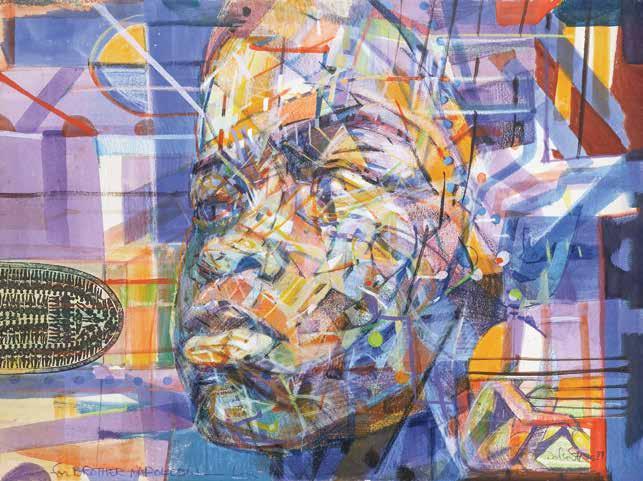 MARYLAND GLOBAL CAMPUS
Untitled, 1988, collage and color pencil, 197⁄8 x 26 inches, Collection of Napoleon Jones-Henderson of the Research Institute of African and African Diaspora Arts, LLC
MARYLAND GLOBAL CAMPUS
Untitled, 1988, collage and color pencil, 197⁄8 x 26 inches, Collection of Napoleon Jones-Henderson of the Research Institute of African and African Diaspora Arts, LLC